The Infrastructure Show's Episodes
With Host Professor Joseph Schofer of Northwestern University.
Click on the link below the description to begin streaming the podcast. To subscribe to The Infrastructure Show podcasts or find in iTunes, see the clicks at the top of the page.
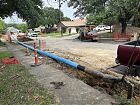
Pipe bursting in progress, photo courtesy of the City of Irving, Texas
(click for larger image)
Fast-Growing Cities Need Rapid Water System Upgrades – How Irving, Texas, Does It
Posted August 29, 2025, Length: 33:19
Irving, Texas, a city of about 255,000 people near Dallas, is growing fast, and its water supply and wastewater systems must be upgraded to support rapidly increasing demands. To do this, Irving has created a multi-year, citywide program to maintain and expand its water management systems. To learn more about this large-scale municipal infrastructure program, we talk with Walt Thomas, City Engineer for Irving. Walt earned a BS in civil engineering from Texas Tech University and an MS in Public Administration from the University of Texas.

Caption: Removing Copco-2 Dam on the Klamath River, Photo courtesy of Shane Anderson/Swiftwater Films
(click for larger image)
Removing Dams on the Klamath River – Why and How
Posted July 30, 2025, Length: 24:22
Four dams were removed from the Klamath River in 2023-24 to bring it back to its natural, wild state. These dams provided water and power to the region but blocked spawning salmon, and they were declared economically inefficient by their owner. This was the largest dam removal effort in U.S., leading to the restoration of the river, its environment, and services to Native American communities.
To explain the motivations, methods, and outcomes of this project, we talk with Brian Graber, Senior Director of Dam Removal Strategies for American Rivers, a 50-year-old not-for-profit organization which advocates for the health and restoration of U.S. rivers. Brian earned a B.A. in geography from Dartmouth College, and M.S. degrees from the University of Wisconsin-Madison in civil and environmental engineering and in geography.
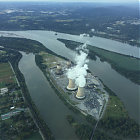
Aerial view of Three Mile Island nuclear power plant, Pennsylvania, September, 2019, courtesy of Wikipedia Commons, Creative Commons Attribution-Share Alike 4.0 International license, author Groupmesa.
(click for larger image)
Rebooting Three Mile Island
Posted July 2, 2025, Length: 22:20
In 1979, one of two nuclear reactors at the Three Mile Island power plant near Harrisburg, Pennsylvania, suffered a partial meltdown. The second reactor was shut down 40 years later for economic reasons. Now, work is underway to restart that second reactor to produce electricity for a single customer, Microsoft. To learn what it takes to restart and ensure the safety of a nuclear power plant, and to explore the role of nuclear energy in a mix of renewable resources, we’ve invited back Dr. Elmer Lewis, professor emeritus of mechanical engineering at Northwestern University. Dr. Lewis is the author of the books “Nuclear Power Reactor Safety” and “Fundamentals of Nuclear Reactor Physics,” and he will soon publish his latest book, “Renewables or Nuclear, Which Should Lead in Curbing Climate Change?”

Construction of the Purple Line Light Rail System, a P3 project, Silver Spring, MD, photo courtesy of Robert L. Peskin.
(click for larger image)
Financing Transportation Through Public-Private Partnerships
Posted June 1, 2025, Length: 34:19
Public-private partnerships (P3s) can be important strategies for financing transportation and other large infrastructure projects. Advancing public infrastructure projects with P3s requires careful analysis of the associated costs and the sharing of risks and rewards.
To learn about trends in P3 financing, we speak with Professor Jonathan Gifford of the Schlar School of Policy and Government at George Mason University and Director of the Center for Transportation Public-Private Partnership Policy. Jonathan earned his BS in civil engineering from Carnegie Mellon University and an MS and PhD in civil engineering (transportation) at the University of California, Berkeley.
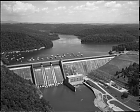
TVA’s Norris Dam, a hydroelectric and flood control dam on the Clinch River in Tennessee, completed in 1936., Courtesy TVA
(click for larger image)
The TVA After Nine Decades
Posted May 1, 2025, Length: 20:02
The Tennessee Valley Authority (TVA) is the largest public power company in the United States. It also controls flooding, assures navigability and recreation, and protects the environment across seven states on the Tennessee River System. Established in 1933 to combat the depression, TVA is in its ninth decade as a self-sustaining entity.
To understand the TVA as an enduring infrastructure project, we talk with Pat Ezzell, senior program manager and resident historian for TVA. Pat has authored a number of articles and two books on TVA history. She also hosts a social media and video series highlighting the TVA region.

Francis Scott Key Bridge Destroyed by Strike from MV Dali Courtesy of the U.S. Army Corps of Engineers (public domain)
(click for larger image)
Ship Collisions with Bridges – the Risks and Protection Options
Posted April 1, 2025, Length: 32:24
Ships hit bridges much more often than people realize, and while most of the outcomes are minor, such events can present big risks to bridge users, ship operators, and infrastructure. Bridge design standards that address such risks are issued and updated periodically by the American Association of State Highway and Transportation Officials, but they do not mandate adding protection to existing bridges. Yet the size of ocean-going cargo has grown substantially in the past 30 years, amplifying the risks for bridges over ocean-connected waterways.
To understand just how safe our major U.S. bridges are today, we talk with Mike Winters, P.E., who is Senior Structural Engineer with Moffatt & Nichol, a U.S.-based global infrastructure advisor. Mike is the principal U.S. representative to an international committee established by the Permanent International Association of Navigation Congresses to develop guidelines associated with ship collisions with bridges and other fixed structures.
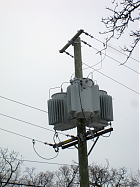
Cluster of pole-mounted, neighborhood step-down transformers, Evanston, Illinois, photo by Joseph Schofer.
(click for larger image)
Transformers – Their Vital Role in Ensuring Electric Grid Reliability
Posted March 1, 2025, Length: 20:01
Transformers step-down voltage from high levels most efficient for long distance transmission to lower levels for safe distribution to homes and businesses. Having enough transformers for replacement and to support expansion of the electrical grid is essential for ensuring reliability of the power system, but currently there is a shortage of transformers.
A study by the National Renewable Energy Laboratory (NREL), a U.S. Department of Energy lab, assessed the factors affecting demand for distribution transformers. To tell us about the findings of this analysis is one of the authors, Killian McKenna, Group Manager of Electrical Engineering for NREL. Killian earned a PhD in Electrical Engineering from University College Dublin.
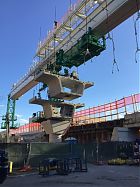
Gantry places precast concrete bridge segments for new elevated structure, courtesy of Chicago Transit Authority.
(click for larger image)
Rebuilding Chicago Transit Authority’s Red and Purple Rail Lines
Posted February 1, 2025, Length: 21:33
The Chicago Transit Authority’s $2.1 billion Red and Purple Line Modernization Project (RPM) is rebuilding a 5.6-mile elevated rail rapid transit structure and four stations, ensuring structural integrity, expanding capacity, and improving ride quality along a corridor on the North Side of Chicago. Included in this six-year project is removal of a failing embankment and returning land to the community.
Here to talk with us about this project is Grace Ohs, Chicago Transit Authority RPM vice president and project lead. Grace earned her BS in Civil Engineering from the University of Illinois.

Shoalwater Tsunami Tower, Courtesy of Washington Military Department, Emergency Management Division
(click for larger image)
Tsunami Evacuation Towers – Reaching for the Sky to Save Lives
Posted January 1, 2025, Length: 28:23
Earthquakes can generate massive tsunamis that pose severe risks to coastal communities. The 2004 earthquake off Sumatra spawned a tsunami that killed an estimates 228,000 people. Facing its own tsunami risk, the Shoalwater Bay Indian Tribe built an evacuation tower serving the coastal community of Tokeland, Washington. This tower can hold more than 400 people, and it is a model for vertical towers that might be constructed in other tsunami hazard zones.
Here to describe this project is Maximilian Dixon, Earthquake Program Manager for the Washington Military Department’s Emergency Management Division. Maximilian earned three degrees from the University of Washington: a BS in Environmental Policy and master’s degrees in urban planning and infrastructure planning and management.

Image credit: iStock.com/Ole_CNX
(click for larger image)
Digital Twins – Modeling Infrastructure Systems for Design, Operations, and Management
Posted December 1, 2024, Length: 26:18
Digital twins are virtual representations of real systems used to test designs and operating policies in safe environments prior to implementation or offline. Applications include a variety of public and private facilities, notably airports and operating systems such as water supply and manufacturing processes. Much of the work is centered in architectural and engineering firms, with its foundation in Building Information Modeling (BIM).
To understand digital twins and their infrastructure applications, we talk with Howard Shotz, a Vice President at Arora Engineers, where he leads the Global Smart Infrastructure practice. A graduate in architecture from Temple University, Howard is former Director of the Digital Twin and Digital Advisory Practice at Parsons Corporation.

Cascade Lake Dam in Hampstead, MD, courtesy of Maryland Department of the Environment.
(click for larger image)
Dam Failures in the U.S. – the Risks and Risk Management
Posted November 1, 2024, Length: 26:32
Dam failures are frightening, and they can become disasters. Just how common – or uncommon – are the failures of dams in the U.S.? What are the contributing factors and are there ways we mitigate them?
To learn the facts about dam failures, we talk with John Roche, who is Chief of the Dam Safety Permits Division of the Maryland Department of the Environment. John’s work on dams includes emergency preparedness and response, public safety strategy, policy development, hydrology and hydraulics, and natural resources management. John earned his BS in Civil Engineering and MS in Geotechnical Engineering from University of New Hampshire. He’s a registered Professional Engineer in multiple states and is currently Secretary and Board Member of the Association of State Dam Safety Officials.

Caption: Eads Bridge from Laclede’s Landing Photo credit: Wikimedia Commons Photo by Mitchell Schultheis, September 8, 2012.
(click for larger image)
The Eads Bridge at 150: A Story of Innovation in Design, Materials, and International Finance
Posted October 1, 2024, Length: 30:08
The Eads Bridge, opened in 1874, is the oldest functioning bridge across the Mississippi River. This St. Louis crossing, named after its designer/builder, James Eads, pioneered the use of steel, then a new material; the construction of long-span arches without falsework; and deep underwater foundations. Eads himself led the creation of an elaborate international financing scheme to pay for the bridge and promising large profits for its investors. Today the Eads Bridge carries 4 lanes of road traffic and the Metrolink light rail line.
Bringing us the history of this National Historic Landmark is John K. Brown, whose recent book, Spanning the Gilded Age; James Eads and the Great Steel Bridge, presents this story in detail, addressing financing of the economic expansion of the post-Civil War United States; the self-dealing and conflicting interests of the banking, railroad, construction, and materials industries of the time; as well the beginning of an integrated, standardized U.S. rail network. John is Professor Emeritus in the Department of Science, Technology, and Society at the University of Virginia. He earned three degrees in history: a BA from Emory and MA and PhD degrees from University of Virginia.

Atlanta’s Greyhound Bus Terminal Photo from the Chaddick Institute collection
(click for larger image)
Saving Intercity Bus Terminals
Posted September 1, 2024, Length: 19:20
Intercity bus terminals are key links in the national bus network. We’re losing some these terminals due to pressures for more lucrative land uses. The announced closing of Chicago’s downtown Greyhound station will be impactful because about half a million passengers pass through it annually. How important are these terminals, not just locally, but in the national intercity bus network? Is there a need for public intervention to save them?
To explore the contributing factors, the implications of closures, and potential interventions, we talk with Professor Joseph Schwieterman of DePaul University in Chicago. Joe is Founding Director of DePaul’s Chaddick Institute for Metropolitan Development, and the foremost scholar on intercity bus transportation in the U.S. He has a BS degree from Purdue, an MS in Transportation from Northwestern, and a Ph.D. in public policy from the University of Chicago.

One of two neutrino detector caverns at the Sanford Underground Research Facility in South Dakota, for the Deep Underground Neutrino Experiment hosted by Fermilab. The caverns are about one mile underground, more the 500 feet long, and seven stories high. Construction required removing 800,000 tons of rock. A third cavern will house utilities for operation of the detector. Photo credit: Matthew Kapust, Sanford Underground Research Facility.
(click for larger image)
Big Infrastructure for Big Science - The Deep Underground Neutrino Experiment
Posted August 1, 2024, Length: 26:59
Scientific research needs supporting infrastructure – some small, some big, but rarely simple. The Deep Underground Neutrino Experiment – DUNE – will study the neutrino, one of the smallest atomic particles that is a fundamental building block of the universe. DUNE will send neutrinos generated at the Long Baseline Neutrino Facility near Chicago 800 miles though the earth to a massive detector in South Dakota, 1500 meters underground, that will collect data for scientists around the world.
To explain the experiment itself, the infrastructure that will make it possible, and how that infrastructure is being built, we’re talking with Ron Ray, Particle Physicist at Fermilab and Deputy Project Director of the LBNF/DUNE project team, to join us. Ron earned his Ph.D. in particle physics from the University of California-Irvine and worked as a scientific researcher at Northwestern University.

Bridge inspection by drone courtesy of Collins Engineers
(click for larger image)
Let Drones Do It – Taking on Bridge Inspection
Posted July 1, 2024, Length: 18:53
Bridge inspectors like to get up close and personal to detect small defects that could grow into disasters. The configuration of bridges – their size, height, and locations – can make the job difficult and dangerous. But rapid advances in aerial drones are making it possible to inspect difficult-to-access areas of bridges quickly and safely, reducing inspection costs and supporting better bridge maintenance.
To update us on recent applications of drones for bridge inspection, we’re talking with Barritt Lovelace, who is Director of Unmanned Aerial Systems, Artificial Intelligence and Reality Modeling at Collins Engineers in St. Paul, Minnesota.
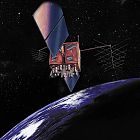
Earth-orbiting Satellite
(click for larger image)
The Global Positioning Satellite System – Fifty Years of Success
Posted June 1, 2024, Length: 23:30
GPS, the Global Positioning System, is now half a century old. This extraordinary technological advance routinely guides planes, ships, trains, automobiles, bikers and pedestrians with high precision. A Defense Department technology, GPS became widely available to the public in 1990. It has displaced and replaced some older navigation systems and brought revolutionary change to location and timing tasks.
To review some of the benefits GPS has brought, we talk with Michael Gallaher, of RTI International, who is co-author of a study of the benefits of GPS for the National Institute of Standards and Technology.

(click for larger image)
Locking the Door on Cyberattacks
Posted May 1, 2024, Length: 24:35
Almost every major system we rely on seems to be vulnerable to cyberattacks from scammers, criminals, and nation states threatening our national security. Reports of cyberattacks disrupting and even destroying critical infrastructure systems are increasingly common.
To understand the cyber risks that threaten our essential service systems and how we can defend against them, we talk with Gregory Falco, Assistant Professor in the Sibley School of Mechanical and Aerospace Engineering at Cornell University and Director of the Aerospace ADVERSARY Laboratory, which designs and develops next-generation autonomous, secure and resilient space infrastructure.

Image courtesy of National Renewable Energy Laboratory
(click for larger image)
Delivering Energy on Demand: Grid-Scale Storage
Posted April 1, 2024, Length: 20:56
Energy from wind and solar sources is available when nature permits, but the demand for energy is based on the cyclical needs of people and their activities. To make renewable energy work, and to manage the normal daily mismatches between supply and demand, we need to shift energy in time from when it is available to when it is needed. That calls for grid-scale storage.
To explain large-scale energy storage strategies, we talk with Nate Blair, group manager of distributed systems and storage analysis at the USDOE National Renewable Energy Laboratory in Golden, Colorado.

Road construction in ice-rich permafrost, courtesy of the Alaska Department of Transportation and Public Facilities
(click for larger image)
When Permafrost isn’t Permanent – Building Infrastructure in Cold Regions
Posted March 1, 2024, Length: 17:42
In very cold places, like Alaska, Northern parts of Canada and Europe, building infrastructure means building on permafrost, perennially frozen ground. Permafrost provides reliable foundations for buildings and highways as long as it remains frozen. But warming temperatures driven by climate change may threaten existing and new infrastructure founded on permafrost.
To help us understand the problems and potential solutions in this dynamic risk environment, we talk with Billy Connor, Director of the Arctic Infrastructure Development Center at the University of Alaska.

Photo caption: Bay Lights on the San Francisco-Oakland Bay Bridge Photo Credit: Illuminate.org
(click for larger image)
The Bay Lights – Bridges as Art
Posted February 1, 2024, Length: 20:35
Spectacular bridges can be focal points of their host cities, reminding us that unique infrastructure can also be unique art. Lighting those bridges can carry their aesthetic value into the night. In 2013, the San Francisco-Oakland Bay Bridge was illuminated with a 25,000-LED dynamic display called The Bay Lights, and its public appeal kept it lighted until 2023.
In this podcast we talk with Ben Davis, Founder of Illuminate, which developed the Bay Lights plan, about the original concept, some of the challenges of lighting massive structures, and plans for its future.
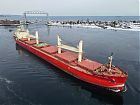
Bulk carrier MV Federal Dart entering Duluth harbor, photo credit: Korey Garceau
(click for larger image)
The Port of Duluth-Superior – Our Largest Freshwater Seaport
Posted January 1, 2024, Length: 22:07
The Port of Duluth-Superior, located at the western end of Lake Superior, is a national and international cargo hub, serving the Great Lakes and, through the St. Lawrence Seaway, the rest of the world. It supports flows of bulk cargoes such as grain, iron ore and coal, and project cargo – large construction equipment.
To learn about its unique role in logistics and the challenges it faces when winter sets in, we talk with Deb DeLuca, Executive Director of the Duluth Seaway Port Authority.
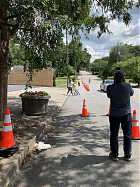
Picture caption: Boulevard Granada Tactical Walk Lane, Southwest Atlanta, Courtesy of the Atlanta Department of Transportation
(click for larger image)
Giving Streets Back to People – Tactical Urbanism in Atlanta
Posted December 1, 2023, Length: 22:11
Some U.S. Cities are taking back streets from exclusive use by motor vehicles to protect and prioritize vulnerable road users – pedestrians and bicyclists – and to enhance neighborhood livability. This process is advanced under the banner of Complete Streets, streets designed and operated for all users. Atlanta, Georgia’s variation is called Tactical Urbanism, a low-cost, quick-build approach designed to change the overall use and feel of streets and public spaces.
To learn how Atlanta uses tactical urbanism, we talk with Betty Smoot-Madison, Deputy Commissioner of Planning for the Atlanta Department of Transportation.
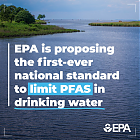
Image courtesy of USEPA
(click for larger image)
Getting PFAS Out of Our Drinking Water (fixed)
Posted November 3, 2023, Length: 20:33
PFAS, per- and polyfluoroalkyl substances, the forever chemicals, are commonly used as protective coatings because they resist heat, stains and water. Because PFAS do not normally degrade in the environment, when products containing them are discarded, they become nearly ubiquitous pollutants in our water supply. Can they be removed? If so, how can we do it and what will it cost?
To get answers to these questions, we talk with Mohamed Ateia Ibrahim, Environmental Engineer and Group Leader at the U.S. Environmental Protection Agency Center for Environmental Solutions and Emergency Response.
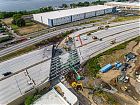
Photo of the I-95 bridge rebuild courtesy of the Pennsylvania Department of Transportation
(click for larger image)
PennDOT Rebuilds I-95 with Recycled Bottles in 12 Days
Posted October 1, 2023, Length: 24:22
On June 11, 2023, a gasoline truck caught fire under I-95 in Philadelphia, essentially melting a major section of the primary roadway through the center of the Northeast Corridor. Facing what looked like a months-long reconstruction process, the Pennsylvania Department of Transportation assembled a quick action team to implement an extraordinary repair effort, built on interagency cooperation and a unique recycled material, restoring I-95 to full use in only 12 days.
Telling us about this quick rebuild is Lou Belmonte, District Executive for the Pennsylvania Department of Transportation.
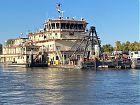
USACE St. Louis District's Dredge Potter worked 24/7 through the 2022-23 dredging season on the Mississippi River. Photo courtesy of USACE, Janet Meredith photographer.
(click for larger image)
Low Water on the Mississippi Blocks Farm Trade
Posted September 1, 2023, Length: 18:42
Fluctuations in water levels on our inland waterways system can affect the movement of bulk freight, particularly agricultural products. Low waters, as occurred in the fall of 2022 on the lower Mississippi River, limited the flow of freight and increased shipper costs.
To learn more about the causes, consequences, and responses to such disruptions, we’re talking with Mike Steenhoek, Executive Director of the Soy Transportation Coalition. Mike is a member of the Department of Commerce Advisory Committee on Supply Chain Competitiveness, the Transportation Research Board Committee on Inland Water Transportation, and the Iowa Department of Transportation Freight Advisory Council.

Photo caption: Current state of the Baltimore and Potomac Tunnel Photo courtesy of Amtrak
(click for larger image)
The New Frederick Douglass Tunnel – Improving Amtrak Services
Posted August 1, 2023, Length: 19:20
The 150-year-old Baltimore and Potomac Tunnel, Amtrak’s oldest, carries traffic for Amtrak, the Maryland Area Rail Commuter (MARC) Service, as well as Norfolk Southern freight operations. This tunnel is a major bottleneck for Northeast corridor rail traffic, and Amtrak is rebuilding it and adding a new, passenger-only tunnel named after abolitionist Frederick Douglass.
In this podcast we learn about this large program from Mark Milton, Senior Director, Capital Delivery for Amtrak, who is managing final design and construction for the overall program. Mark’s a civil engineer with many years of experience in design.
[Correction to interview conversation: all railroad grades on this project are less than 2.0%]

Train derailment near Draffin, KY February 13, 2020 -- photo courtesy of Pike County (Kentucky) Office of Emergency Management with overlay annotations by the National Transportation Safety Board
(click for larger image)
Causes and Prevention of Train Derailments
Posted July 1, 2023, Length: 22:47
US railroads are highly efficient at moving freight. Indeed, our freight rail system is the envy of the world, but sometimes accidents occur. When train derailments occur, the outcome is usually minor, but occasionally more serious problems arise.
To understand the causes and prevention of train derailments, we’re talking with Dr. Allan Zarembski, Professor of Practice and Director of the Railroad Engineering and Safety Program at the University of Delaware. He’s an expert on railroad track engineering, safety, and derailment analysis.

San Mateo County Office Building (COB3) in Redwood City, California, under construction. Photo © Cesar Rubio Photography
(click for larger image)
Mass Timber Buildings – New Ways to Build with an Old Material
Posted June 1, 2023, Length: 20:48
Wood has been perhaps the most common material for buildings for millennia, but innovations in its application are bringing new opportunities and advantages for working with this sustainable material. Structural applications of mass timber are proliferating in types and scales. Factory assembly of wood components can produce stronger elements in designed architectural shapes.
To find out more about the characteristics and benefits of new uses of wood for infrastructure, we talk with Eric Long, Structural Engineering Partner at Skidmore, Owings & Merrill in San Francisco, who leads the firm’s West Coast Structural Engineering practice.

Chart credit: NOAA National Centers for Environmental Information https://www.ncei.noaa.gov/access/billions/time-series
(click for larger image)
Insuring Infrastructure Against Climate Change
Posted May 1, 2023, Length: 24:06
Changing climate brings new risks to infrastructure, and commonly these risks are shared with insurance companies. To control their risks, insurers need to understand and anticipate both the sources and characteristics of natural threats, and to collaborate with their clients – infrastructure owners and operators – to mitigate the risks of natural hazards.
To open a window on the role of insurers in addressing climate risk, we talk with Martin Lockman, a research lawyer working at Columbia University’s Sabin Center for Climate Change Law. Martin works at the intersection of climate-related threats to infrastructure, the insurance industry, and risk management.

Metra locomotives 414 and 419 (MP36PH by MotivePower – division of Wabtec) and 108 (F40PH by Electro-Motive Division of General Motors). Photo courtesy of Metra.
(click for larger image)
Transforming Commuter Rail Services for a Post-COVID Market
Posted April 1, 2023, Length: 24:39
COVID-19 has robbed public transit of riders as many have changed workplaces, shifted schedules, and chosen new ways to travel to avoid crowds. Transit operators around the world are working to attract commuters back, adjusting services and fares to accommodate changing markets, secure reliable revenue sources, and redefine their roles in the city.
To tell us more about both the challenges and responses of a major commuter rail operator, we’ve invited James Derwinski to talk with us. Jim is CEO and Executive Director of Metra, the commuter rail system serving the Chicago Metropolitan area, the fourth largest in the US in terms of trips carried, and the largest in terms of route miles.

Photo of small transit vehicles courtesy of the Community Transportation Association of America
(click for larger image)
Rural Transit Meets Big Challenges
Posted March 1, 2023, Length: 25:57
Mobility is essential for the well-being of people wherever they live. The automobile is king of the mobility market across the US, but public transit supports mobility for those who cannot, or chose not to, travel by car. The need for alternatives to automobility in smaller communities and rural areas is substantial but not especially visible.
To understand the role and options for transit in such places, we talk with Scott Brogen, who is Executive Director of the Community Transportation Association of America.

Repairing buckled pavement on Interstate 5 in Shoreline, WA, caused by 2021 northwest heatwave. Photo by Bruce Sounder, Wikipedia Creative Commons
(click for larger image)
Overheated Infrastructure
Posted February 1, 2023, Length: 24:26
A hotter climate brings new challenges to the built infrastructure, stressing service systems – power generation and distribution and transportation systems – as well as structures. Are we prepared for these problems? How can infrastructure adapt to higher temperatures?
To understand both the problems and options, we talk with Mikhail Chester, Associate Professor in the School of Sustainable Engineering and the Built Environment at the Fulton School of Engineering, and Director of the Metis Center for Infrastructure and Sustainable Engineering, at Arizona State University.
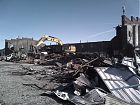
Building demolished during cleanup at Eagle Zinc Superfund site. Photo courtesy of EPA
(click for larger image)
Restoring a Superfund Site
Posted January 1, 2023, Length: 21:55
Superfund sites are seriously polluted locations that are subject to remediation by the Environmental Protection Agency under the 1980 Comprehensive Environmental Response, Compensation and Liability Act (CERCLA). These clean-up processes can be large, complex, and costly.
To understand what it takes to restore a particularly challenging location, the 132-acre Eagle Zinc Superfund site in Hillsboro, Illinois, we talk with the EPA’s Margaret Gielniewski, who is Remedial Project Manager.

Photo credit: USDA
(click for larger image)
Lighting Up the Farms
Posted December 1, 2022, Length: 21:12
This podcast is a timely history lesson about the electrification of rural America and the Depression-era program that made it happen. The Rural Electrification Act of 1936 – the REA – provided federal loans to install electrical distribution systems to serve rural areas. The REA may offer lessons as we invest to extend high speed broadband service across the country.
To learn about the REA and its impacts, we’re talking with Price Fishback, APS Professor of Economics at the Eller College of Management of the University of Arizona, an expert on the political economy of Roosevelt’s New Deal during the 1930s.

The Port of Virginia Photo courtesy of the Virginia Port Authority
(click for larger image)
Keeping the Port of Virginia Flowing
Posted November 1, 2022, Length: 20:55
Marine ports are gateways to world trade, and their efficient functioning is a pillar of our economy. East and Gulf Coast ports have grown more important in recent years because of the expanded Panama Canal locks opened in 2016 and continuing congestion in West Coast ports and overland transportation. The Port of Virginia has been making important infrastructure investments to secure its position in this competition for world trade.
To learn how it became the second busiest container port on the East Coast, in this podcast we talk with Stephen Edwards, CEO and Executive Director of the Virginia Port Authority (VPA).

Photo courtesy of US GAO
(click for larger image)
Motor Vehicles and Trains - a Deadly Mix
Posted October 1, 2022, Length: 24:38
Railroads and motor vehicles can come into conflict at level, or at-grade crossings. Such conflicts almost always lead to deadly consequences. In this podcast we consider the trend in rail grade crossing crashes, and the differences that crossing control devices, education, and other policies might make toward mitigating this risk.
To understand how we can make these intersections safer, we talk with Professor Ian Savage of Northwestern University, a transport economist who studies the economics of transportation safety, including rail safety.

Photo of Merchants Bridge project, courtesy of The Walsh Group.
(click for larger image)
Rebuilding the Merchants Bridge while Keeping Traffic Moving
Posted September 1, 2022, Length: 17:16
Replacing an active railroad bridge while limiting disruptions to both rail and river traffic presents significant challenges in design and construction staging. The 1889 Merchants Bridge at St. Louis – the oldest remaining rail bridge across the Mississippi River – needed to be upgraded to modern standards. The work involved removal and replacement of three truss spans, accomplished in separate time windows, and demanding the precise coordination of multiple contractors, as well as rail and waterways operations.
In this podcast we talk with Dan Sieve, Senior Project Manager for Walsh Construction, the company that led the effort, to learn how the work was done.
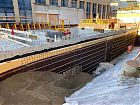
Photo caption: Installation of an energy wall for a building located in Lausanne, Switzerland (photo courtesy of GEOEG).
(click for larger image)
Energy from the Earth – How does it work?
Posted August 1, 2022, Length: 22:23
Because temperatures below the surface of the earth are relatively constant year around, the earth can be used as a heat sink or source to cool or heat buildings, offering an energy source that is not only carbon-free, but is also constant. How does this work? Where and how can we use this seemingly free energy source?
To answer these questions, we talk with Alessandro Rotta Loria, Assistant Professor of Civil & Environmental Engineering at Northwestern University, who studies the connections between geomechanics, energy, and environmental sustainability.

The wreckage of a home improvement store after the May, 2011, Joplin, MO tornado; photo courtesy of NIST.
(click for larger image)
Tornado-Resistant Building Standards
Posted July 1, 2022, Length: 27:11
Over 1200 tornadoes strike the U.S. each year, bringing destruction, injuries, and deaths to communities. Until recently there were no structural design standards specifically aimed at providing some tornado protection for buildings.
In this podcast we talk with Dr. Marc Levitan, Lead Research Engineer at the National Institute of Standards and Technology’s National Windstorm Impact Reduction Program, to learn about tornadoes, the research he has done to lead the development of ASCE wind loading standards for designing structures to resist them, and the process for moving research into enhanced building codes.
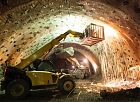
Photo courtesy of Eno Center for Transportation
(click for larger image)
Building More Cost-effective Rail Transit
Posted June 1, 2022, Length: 25:26
Is it more costly to build urban rail infrastructure in America? Does that affect the quality of the products? If so, can we do anything to control costs and get more value for our money?
The Eno Center for Transportation, an independent think tank, conducted an extensive study to answer these questions. To tell us what they learned, Paul Lewis, Eno Vice President for Policy and Finance and a co-author of the study, joins us in conversation.

Photo caption: Photo of Indian River Lagoon-S C-44 Pump Station, Reservoir and Stormwater Treatment Area, courtesy of the USACE.
(click for larger image)
Restoring the Everglades
Posted May 2, 2022, Length: 20:07
The Everglades is a huge wetland – an area permanently covered with water – that includes a variety of unique ecosystems delivering essential services to both natural and human development systems, including water storage, treatment, flood control, and providing habits for many creatures and plants. Occupying much of Florida south of Orlando, the Everglades has felt the effects of human activities for hundreds of years. The Comprehensive Everglades Restoration Plan (CERP) is a congressionally mandated, 35-year federal/state collaboration that is restoring, preserving, and protecting the Everglades.
To learn more about the Everglades and CERP we invited Eva Velez, Chief of the Ecosystems Branch of the Jacksonville District of the U.S. Army Corps of Engineers, to talk with us.
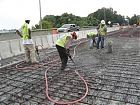
Photo credit: Bridge deck replacement, photo courtesy of Virginia Department of Transportation
(click for larger image)
Keeping Bridges in Good Repair
Posted April 1, 2022, Length: 23:49
We rely on state and local highway agencies to assure the safety and functionality of the more that 618,000 bridges the American public traverses on a daily basis. The sheer numbers, our aging bridge population, and limits to funding make this a large and demanding responsibility. How do these agencies assess the condition of our bridges and set priorities for repair and replacement?
To learn how one state department of transportation works to assure that its bridges are in a state of good repair, we talk with Todd Springer, Assistant State Structure and Bridge Engineer for Design and Project Delivery at the Virginia Department of Transportation.

Photo credit: Photo of curbside management courtesy of the University of Washington Supply Chain Transportation and Logistics Center
(click for larger image)
Managing Curbside Access in Cities
Posted March 1, 2022, Length: 16:45
Competition for urban curb space can be fierce on a day to day basis, and a policy and technical challenge for longer term planning. Delivery companies and their customers, people trying to park their cars, pedestrians, and bike riders are all in the mix. How common is this competition? What are the options for allocating scarce curb space so all of the important needs are met?
To learn about this problem and possible solutions, we talk with Anne Goodchild, Professor of Civil & Environmental Engineering and Director of the Supply Chain Transportation & Logistics Center at the University of Washington.

Water well drilling photo courtesy of National Ground Water Association
(click for larger image)
Groundwater: Surprisingly Important, Significantly at Risk
Posted February 1, 2022, Length: 27:38
Groundwater is the source of about 40 percent of our potable water, and thus it is important for many households, farms, manufacturing, and other processes. In some places groundwater is contaminated, or at risk of contamination. In many placed it is being used at rates faster than it is being recharged. How do we manage groundwater? What are the risks that it faces, and what can we do about them?
In this podcast we talk with Dr. Bill Alley, Director of Science and Technology, for the National Ground Water Association.
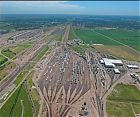
Union Pacific Bailey Yard in North Platte, NE, the largest classification yard in the world. Photo courtesy of The Golden Spike Tower
(click for larger image)
The End of the Line – the Story of Railroad Terminals
Posted January 3, 2022, Length: 31:47
Rail terminals are the beginning and end points of the rail freight journey, and they serve a key sorting function for merchandise trains, those carrying mixed freight. Rail terminals are large, complex, and varied in their characteristics, and their functioning is critical to the success and efficiency of rail freight and the broader U.S. supply chain logistics system.
To learn about railroad terminal operations and design, we talk with an expert on the subject, Rich Gray, who served as General Director of Asset Planning before retiring from the Union Pacific Railroad.

Photo credit: Photograph of Erie Canal Locks at Little Falls, taken late nineteenth-early twentieth century; courtesy of New York State Museum.
(click for larger image)
Looking Back on the Erie Canal
Posted December 1, 2021, Length: 23:59
History can be a great teacher, particularly so when it comes to infrastructure achievements. During the Bicentennial period of the construction of the Erie Canal, it is appropriate and informative to look back at this groundbreaking infrastructure project. Built between 1817 and 1825, the Erie Canal opened the Midwest to trade and settlement, and by cutting freight rates by 75% overnight, it boosted the commercial power of New York City. It offers lessons about the link between accessibility and economic development, the merits of strategic public investment, as well as the conflicts that can occur in public finance decisions.
To remind us of this history, we’re joined by Brad Utter, Senior Historian and Curator at the New York State Museum and author of the 2020 book, Enterprising Waters – the History and Art of New York’s Erie Canal.

Prologis warehouse, Tracy, California, courtesy Prologis
(click for larger image)
Logistics Real Estate: Meeting the Demand for Warehouses and Distribution Centers
Posted November 1, 2021, Length: 18:43
Beyond the capability to move products, supply chains need storage space for transferring and holding goods en route and while they await shipment to customers. Sufficiency – and efficiency – of logistics real estate, warehouses and distribution centers, are essential attributes of well-run supply chains. How does the logistics real estate sector work? What factors drive the market and assure that customer demands are met?
To learn how the space needs of the logistics industry are met, we talk with Christopher Caton, Global Head of Strategy and Analytics with Prologis, which builds and invests in logistics space around the world.

Flooding on Interstate 29, 24 miles north of Council Bluffs, IA, October, 2019. Photo courtesy of the Iowa Department of Transportation
(click for larger image)
Moving Traffic When Flood Waters Rise
Posted October 1, 2021, Length: 18:09
It’s the functionality of infrastructure that brings value, and when natural hazards disrupt that functionality, the costs can be high. This is a growing problem for transportation networks, which are being assaulted by wildfires, landslides, and floods with increasing frequency and severity. What does it take to keep a road network flowing when the flood waters rise?
To learn about this critical role for the economy and society, we talk with Austin Yates, engineer with the Iowa Department of Transportation, which has had more than its share of flood disruptions in recent years.

Photo of Goethals Bridge project courtesy of The Port Authority of New York and New Jersey
(click for larger image)
Borrowing for Infrastructure
Posted September 1, 2021, Length: 18:08
Big infrastructure projects need big money, and larger projects rely on some kind of borrowing – using other people’s money for a period of time.
To learn how infrastructure projects are financed through borrowing, we talk with Scott Trommer, Senior Director, Advisory Services US at WSP USA, a professional services firm specializing in, among other things, infrastructure and transportation.

Photo courtesy of the U.S. Department of Energy
(click for larger image)
Delivering the Power – What’s Behind the Electric Grid?
Posted August 2, 2021, Length: 25:15
Electric power operates our homes and businesses, and it promises to be the future of mobility, as well. There is a constant need to match temporal and spatial variations in supply and demand for electricity across regions of the country. This need grows as we increase the share of electricity coming from renewable sources, particularly wind and solar, which are time-dependent. We rely on the electric grid to move electric power from sources to need centers.
To learn how the grid works, and how it might be improved, we talk with James McCalley, who is London Professor in Electrical Engineering at Iowa State University.
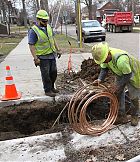
Photo courtesy of American Water Works Association
(click for larger image)
Getting the Lead Out
Posted July 1, 2021, Length: 20:57
The health risks posed by lead water service lines are well known. Just how common is this invisible hazard in our potable water? What can we do to address it? To explore the problem, responses to it, and the costs, we talk with Steve Via, Director of Federal Relations for the American Water Works Association.

Folded plate bridge system being installed using ABC for Pennsylvania Department of Transportation.
(click for larger image)
The ABCs of Accelerated Bridge Construction
Posted June 1, 2021, Length: 18:29
Building or replacing highway bridges quickly can save traffic delays by cutting on-site construction time. What are the design and construction strategies that make this possible?
To answer this question we talk about Accelerated Bridge Construction (ABC) with Professor Atorod Azizinamini, who leads Florida International University’s USDOT-funded Accelerated Bridge Construction University Transportation Center.

Photo of Daniel Patrick Moynihan Train Hall, courtesy of Lucas Blair Simpson, Skidmore, Owings & Merrill
(click for larger image)
Moynihan Train Hall - Designing a New Future for a Classic Building
Posted May 4, 2021, Length: 17:14
On January 1, 2021, a new life began for the century-old James A. Farley Post Office in Manhattan when it became the home of the Daniel Patrick Moynihan Train Hall serving Amtrak and Long Island Railroad passengers. Preserving the Beaux-Arts exterior of the McKim, Mead & White post office, architects created a 21st century interior space bridging New York’s design history and its future.
To learn about the significance and the unique challenges of this complex, adaptive reuse project, we talk with Marla Gayle, Managing Director, Global Transportation Practice and Global Adaptive Reuse Practice with Skidmore Owings and Merrill’s New York Office.
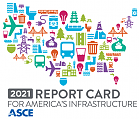
Image courtesy of ASCE
(click for larger image)
Our 2021 Infrastructure Grade
Posted April 2, 2021, Length: 21:52
A national perspective on the condition and performance of our infrastructure is important for informing the dialog about investing in this system that is so important for supporting our society and economy. Every four years the American Society of Civil Engineers works with its volunteer members to produce a comprehensive report card on the state of the U.S. infrastructure.
To give us our 2021 infrastructure grade, we’re talking with Emily Feenstra, ASCE’s Managing Director – Government Relations and Infrastructure Initiatives.

Photo of Valencia Street Bikeway courtesy of the San Francisco Municipal Transportation Agency
(click for larger image)
Redesigning Streets for People
Posted March 2, 2021, Length: 18:10
City streets do much more than just move traffic. They connect to our homes and businesses, supporting not just motor vehicles but pedestrian and bicycle traffic as well, and serving in the way of the ancient forum by proving spaces to shop, mingle, and play. Many large cities are diversifying the use of their streets by reconfiguring them to accommodate this multiplicity of functions safely.
To learn about some of these initiatives, we talk with Jamie Parks, who is Livable Street Director with the San Francisco Municipal Transportation Agency.

Iowa Interstate mixed freight train at Marengo, IA; photo by Frank Grizel
(click for larger image)
Short Line and Regional Railroads
Posted February 1, 2021, Length: 21:25
Railroads helped grow our nation, supporting settlement and economic growth from coast to coast. Today, the rail industry plays a central role in the most efficient freight and logistics system in the world. The 7 national, Class I railroads are well-known to most of us, but less visible yet no less significant in the U.S. freight industry are about 600 short line and regional railroads that make the connections directly to customers.
To learn about the role of these smaller railroads, we’re talking with Henry Posner III, who is Chairman of the Iowa Interstate Railroad and President of the Rail Development Corporation, a holding company with ownership and operating interests in railroads in the U.S., the Americas, and Europe.
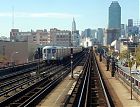
Photo of New York City Metropolitan Transportation Authority Number 7 subway line, courtesy Federal Transit administration
(click for larger image)
The Future of Big Cities after COVID-19
Posted January 4, 2021, Length: 14:52
What’s the path forward for large cities once COVID-19 is controlled? Will workers and residents come back downtown? Will riders return to mass transit systems? How can we sustain them until then? Will the demand for private and public infrastructure rebound to attract investment and growth? Where will the money come from?
To get some answers, we talk with Edward Glaeser, the Fred and Eleanor Glimp Professor of Economics at Harvard, an expert on cities and the values they bring. In his 2011 book, Triumph of the City, he describes big cities around the world as hubs for opportunity and innovation.
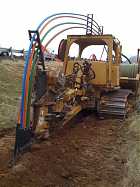
Installing fiber optic conduit along I-15, Utah Photo credit: Federal Highway Administration
(click for larger image)
Broadband Access - Technology and Policy
Posted December 2, 2020, Length: 22:28
Is the Internet a part of U.S. infrastructure? Although the physical infrastructure that carries the data is largely invisible, broadband Internet communication has become a backbone of our society and economy, carrying messages that support work, learning, purchasing, social connections, and medical services. Despite its centrality to daily life, fast and reliable broadband connectivity is not available to everyone.
To help us learn more about the functioning and coverage of the broadband network, we talk with Fabian Bustamante, Professor of Computer Science at Northwestern University.

Photo of Fargo-Moorhead Floodgate Model courtesy of U.S. Army Corps of Engineers
(click for larger image)
Models for Designing Flood Mitigation Infrastructure – The Fargo-Moorhead Project
Posted November 2, 2020, Length: 21:03
River basins in the Midwestern U.S. are under growing threat from flooding driven by climate change. Within the flood control and protection portfolio of the U.S. Army Corps of Engineers is a large project to mitigate flood risk for the towns of Fargo, ND, and Moorhead, MN, its neighbor across the Red River. The design itself is informed by a large-scale physical model developed by the Corps.
To learn about the project and the model used to guide its design, we talk with Gary Bell, Research Hydraulic Engineer in the Coastal and Hydraulics Laboratory of US Army Corps of Engineers Research and Development Center in Vicksburg, Mississippi.
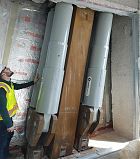
Four large linear dampers installed in 181 Freemont Street, San Francisco, photo courtesy of Arup
(click for larger image)
Managing Motion in Tall Structures
Posted October 1, 2020, Length: 17:52
All tall structures are designed to sway in response to wind and earthquakes for reasons of efficiency and economy, but it is important to control that movement for the comfort of occupants.
To learn about some of the technologies for managing the response of tall buildings to wind, we talk with Dr. Mark Nelson, who leads the Advanced Technology and Research Group in the New York City office of Arup, an international engineering and architectural design firm.
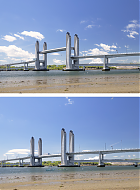
Top: Sarah Mildred Long Bridge in a raised position (for large ship traffic). Bottom: Bridge in a middle position (for roadway traffic). Photos courtesy of FIGG.
(click for larger image)
A Unique Double Decker: The Sarah Mildred Long Bridge
Posted September 1, 2020, Length: 20:54
Crossing the Piscataqua River at Portsmouth, N.H., the Sarah Mildred Long Bridge carries both road and rail traffic between Maine and New Hampshire. Its unique three-position vertical lift design accommodates recreational and less frequent commercial marine traffic, as well as occasional rail movements, in different ways to minimize delays to all users.
To understand the functioning of this modern incarnation of its nearly 80-year old predecessor, we talk with Jeff Folsom, who is Assistant Program Manager/Design for the Maine Department of Transportation.

Photo of cable laying ship MV Decisive courtesy of Subcom, LLC
(click for larger image)
Unseen Infrastructure: Submarine Cables
Posted August 3, 2020, Length: 17:17
People began laying undersea cables to carry telegraph messages over 170 years ago. Today, modern submarine cables connect all continents except Antarctica, and even in the age of satellites, their importance in delivering global connectivity continues to grow.
To help us understand the intricacies of these invisible links, we talk with Chris Carobene, Vice President of Marine and Network Construction for SubCom, which designs, manufactures, deploys, maintains, and operates undersea cables.

Photo of night concrete work courtesy of Salt Lake City International Airport
(click for larger image)
A New Airport for Salt Lake City
Posted June 29, 2020, Length: 19:07
Salt Lake City is replacing the landside infrastructure of its airport with a 21st century facility while airline operations continue. In fact, the slowdown in air travel due to the corona virus has presented airport management with an opportunity to accelerate construction and cut costs.
To describe plans for the updated airport and how the pandemic was used to advantage, we talk with Bill Wyatt, Executive Director of the Salt Lake City International Airport.

Photo credit: FEMA
(click for larger image)
Moving to Higher Ground – Retreat as a Response to Climate Change
Posted June 1, 2020, Length: 20:29
Rising sea level driven by climate change is threatening some coastal settlements with more frequent flooding and potential inundation. For some, the time may come to consider relocating to higher ground. This is a controversial and costly option, a difficult choice for communities and their leaders.
In this podcast we talk with A.R. Siders, Assistant Professor at the University of Delaware’s Biden School of Public Policy and Administration, who is a leading researcher on the topic of strategic retreat.

Photo of Independence Bridge courtesy of the City of Bay City
(click for larger image)
Bay City, MI Chooses Private Solution for Financing Bridge Replacement
Posted May 6, 2020, Length: 16:58
When aging infrastructure needs repair or replacement, a primary challenge is finding the money. Bay City, Michigan, northwest of Detroit, faced this problem with two key bridges, and the community ultimately decided to sell the bridges to a private consortium that will pay for improvements and collect tolls to finance the projects.
In this podcast, we learn how Bay City is addressing its bridge issues from the town’s City Manager, Dana Muscott.

11th Street Bridge Park EEC, aerial view Photo courtesy OMA+OLIN
(click for larger image)
Making Roads Into Parks - Washington, DC’s 11th Street Bridge Park Project
Posted April 2, 2020, Length: 22:01
Sometimes obsolete infrastructure can become a new asset. That’s Washington, D.C.’s plan for an unneeded highway bridge over the Anacostia River. The 11th Street Bridge Park, set for construction starting in 2021, will bring green and hard-surface open space, event venues, and new access to the river itself to the southeast sector of the District of Columbia.
In this podcast, Scott Kratz, Director of the project, gives us the details of this new urban feature.

Photo of Hampton Roads I-64 Bridge-Tunnel, South Island, Photo Credit: Virginia Department of Transportation
(click for larger image)
Building the New Hampton Roads Bridge-Tunnel
Posted March 2, 2020, Length: 18:34
Hampton Roads isn’t a road, but a body of water that links the James, Elizabeth and other rivers to the Atlantic Ocean. It is surrounded by Norfolk, Virginia Beach, and several other cities, and it’s the home of U.S. Naval sea and air operations and the Newport News shipyard. Several busy bridge-tunnel combinations span the 4-mile channel, and growing highway congestion has motivated the construction of another bay crossing.
To learn the why and how of this latest mega-crossing we talk with project director James Utterback of the Virginia Department of Transportation.
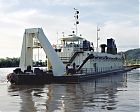
US Army Corps of Engineers 20 inch cutterhead suction dredge Goetz, Photo Credit: US Army Corps of Engineers
(click for larger image)
The Importance of Dredging to Transportation on the Upper Mississippi River
Posted February 3, 2020, Length: 17:38
Persistent flooding in the upper Midwest poses risks to navigation on the Upper Mississippi River. Erosion and sedimentation are reducing channel depths and creating sandbars that block or reduce the capacity of barge tows carrying agricultural and other bulk products. This puts extra demand on channel dredging, which is the responsibility of the U.S. Army Corps of Engineers.
To understand both the problems and responses, we talk with Steve Tapp, Operations Manager in charge of dredging and channel maintenance for the St. Paul District of the Army Corps.

(click for larger image)
Battling Snow on the Roads of Colorado
Posted January 7, 2020, Length: 19:46
Colorado gets plenty of snow in the winter – some mountain areas dig out of as much as 40 feet in a season. Keeping the state roads open and safe for trucks and cars is both important and demanding.
To find out more about how it’s done, the role technology is playing, we are speaking with Kyle Lester, who is Director of Maintenance and Operations for the Colorado Dept. of Transportation.

Photo courtesy of the Metropolitan Water Reclamation District of Greater Chicago
(click for larger image)
Storing Stormwater Underground - Chicago’s Deep tunnel System
Posted December 11, 2019, Length: 20:01
Managing stormwater in cities is important to reduce flooding and secure people and property. Stormwater needs some kind of treatment before it flows to surface waters, and that treatment can be essential in older areas where stormwater and sanitary waste are collected in combined sewers. The Chicago area has built a network of underground tunnels to store that stormwater for later treatment before it goes to the river.
To understand this extraordinary project we’re talking with Kevin Fitzpatrick, Managing Civil Engineer for the Metropolitan Water Reclamation District of Greater Chicago, who works on what is called the Tunnel and Reservoir Plan.

Photo courtesy of Norfolk Southern Corporation
(click for larger image)
Precision Scheduled Railroading
Posted October 29, 2019, Length: 14:54
The US freight railroad system is moving to a different operating strategy, called Precision Scheduled Railroading (PSR), intended to speed up service, get better utilization from infrastructure, and reduce operating costs. What is it and why does it matter?
In this interview, we learn about PSR from John Friedmann, who is Vice President-Network Planning and Optimization for the Norfolk Southern railroad.
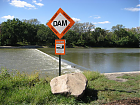
Photo courtesy of the Association of State Dam Safety Officials.
(click for larger image)
Dam Dangers – The Risks of Low-Head Dams
Posted September 30, 2019, Length: 17:46
People have been building dams for centuries to impound water for drinking and recreation, to support navigation, to manage floods, and as a source of hydroelectric power. But dams can also present dangers. Low-head dams, in particular, can pose invisible and deadly hazards to swimmers and boaters.
To learn more about these dams, the risks they present, and what we can do about them we talk with Roger Adams, President of the Association of State Dam Safety Officials, and Paul Schweiger, a member of the Association and Vice President and Dams and Hydraulics Section Manager with Gannett Fleming.

Picture credit: Geothermal plant, photo courtesy of the California Energy Commission
(click for larger image)
The Geysers Geothermal Field in California – the World’s Largest Geothermal Energy Producer
Posted September 5, 2019, Length: 17:55
Geothermal energy brings steam created with the heat of magma deep in the earth to generate electric power. California is endowed with numerous sites where magma is close enough to the surface to make geothermal energy practical. The Geysers, a geothermal field in northern California, is the world’s largest source of geothermal electric energy, where six different companies use steam from 350 wells to provide enough electric power to support nearly half-a-million homes.
To learn more about the Geysers, and to explore the functionality and sustainability of geothermal power, we talk with California Energy Commissioner Karen Douglas, an attorney and one of five members of the commission.
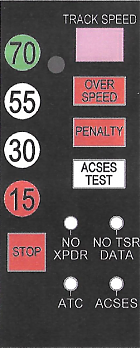
Aspect Display Unity (ADU) to inform locomotive engineer whether the train is operating under cab signal system or ACSES Advanced Civil Speed Enforcement System Positive Train Control. Picture credit: New York and Atlantic Railroad
(click for larger image)
Positive Train Control
Posted July 26, 2019, Length: 20:03
Positive Train Control, or PTC, is a set of technologies designed to assure that our railroad system is protected from collisions and error-driven accidents. The system tracks the location of trains, compares their immediate operations to infrastructure limits, the presence of other trains, and other sources of risks, and guides operators, or the trains themselves, to avoid accidents.
PTC is a complicated and varied system being deployed across the nation. Two distinct systems are in use – Interoperable Electronic Train Management System (I-ETMS) and ACSES – Advanced Civil Speed Enforcement System. To help us understand these systems and to learn more about PTC, we talk with Paul Victor, an experienced railroader and former President of the New York and Atlantic Railroad, a short line railroad serving customers in the New York City Metropolitan area.
Will Stronger Levees Protect Us from the Next Round of Floods?
Posted June 27, 2019, Length: 20:23
Spring flooding in the Mississippi Valley and elsewhere in the U.S. has been extreme in 2019, driven by the usual snow melt amplified by several months of record-breaking rainfall. This pattern seems to grow stronger, and incidents of levee failures have become more numerous. Levees are critical infrastructure components that protect lives and property from floods, but when they fail, the damage grows quickly. Is the solution to build more and stronger levees? Or are there other actions we need to consider?
Discussing both problems and options is Nicholas Pinter, Professor of Earth and Planetary Sciences and Associate Director of the Center for Watershed Sciences at the University of California-Davis.

Excavation for the Wilshire/La Brea station on the Los Angeles Purple Light Rail Line (Aug 2017) Photo Credit: LA Metro
(click for larger image)
Rail Transit Advances in Los Angeles
Posted June 3, 2019, Length: 24:23
In 2008, Los Angeles County voters approved a half-cent sales tax increase to support specific improvements to both highways and transit facilities; in 2016, voters extended and increased that tax to support continued transportation investments.
In this podcast we get a progress report on the investment program and learn about transit projects that will support the 2028 Olympic Games from Phillip Washington, CEO of the Los Angeles County Metropolitan Transportation Authority.

Soo Locks Photo Credit: US Army Corps of Engineers
(click for larger image)
Adding Essential Capacity to the Soo Locks
Posted April 25, 2019, Length: 23:00
The Soo locks bridge a 21 foot elevation difference between Lake Superior and Lake Huron and the rest of the Great Lakes in the Upper Peninsula of Michigan. These locks are an essential link in the U.S. steel supply chain. At the end of 2018, the U.S. Army Corps of Engineers Detroit District, which operates and maintains Soo Locks, advanced the plan to add capacity and redundancy to the Locks by releasing a study analyzing the economic value of investing nearly $1 billion dollars in a new lock. In this podcast we learn about the locks and the findings of this evaluation study from Lt. Col. Greg Turner, Commander of the Detroit District for the Corps.

San Francisco’s tall building inventory; beige shading denotes liquefaction zone Picture Credit: San Francisco Tall Buildings Study, December 2018
(click for larger image)
Earthquake Resilience for San Francisco’s Tall Buildings
Posted March 25, 2019, Length: 19:44
The earthquake risk in California is real, and tall buildings present a particular hazard because they concentrate people and activities, they support critical economic activities, and their scale can pose threats to nearby people and structures. In December of 2018, San Francisco’s Department of Emergency Management released a study of tall buildings focused on damage minimization and quick restoration of functionality. In this podcast we learn about the recommendations in this study from Brian Strong, San Francisco’s Chief Resilience Officer and Director of its Office of Resilience and Capital Planning, the office that oversaw this study.

Photovoltaic panels part of the microgrid at Stone Edge Farm in California. Credit: Courtesy of Stone Edge Farm Microgrid
(click for larger image)
Microgrids for Resilient Power
Posted February 26, 2019, Length: 26:54
Hundreds of large power plants and a nationwide, interconnected distribution network produce and deliver electricity to homes and businesses in the United States. While our electric system is quite reliable (though nowhere near the best compared across nations), cascading failures do shut down parts of the network, and natural disasters, such as hurricanes, snow storms, and earthquakes, can cause widespread power blackouts. Microgrids, partly- or fully-independent sources of localized electrical power, can add resilience and sustainability to the power system. To learn about the characteristics, applications, and motivations for microgrids, we talk with Dr. Chris Marnay, retired staff scientist at Lawrence Berkeley National Laboratory, who is an expert on microgrids and sustainable energy systems.

Credit: Caltrans
(click for larger image)
Wildfires Threaten Highway Infrastructure
Posted January 28, 2019, Length: 12:54
Damaging wildfires in the western U.S. are a growing threat. In California, wildfires destroyed tens of thousands of homes and caused the deaths of nearly 100 people in 2018. Fire also threatens public infrastructure, particularly the highway network, which is essential for both evacuation and the delivery of emergency response resources. To understand how wildfires have affected the state highway system, we talk with Rene Garcia, who is Chief of the California Department of Transportation (Caltrans) Office of Emergency Management and Infrastructure Protection.

Caption: Rendering of new Washington State Ferries Mukilteo Terminal Credit: Washington Department of Transportation
(click for larger image)
Smooth sailing – Washington State Ferry System
Posted December 20, 2018, Length: 18:34
Historically, cities grew up near water – rivers, lakes, the oceans – because of the easy mobility it provides. But water presents a barrier as well as an opportunity, motivating the organized use of ships for local transportation. No city in the United States relies more on ferry transportation for commuting, commerce, and recreation than Seattle, Washington. To learn more about the role of the region’s ferries as a part of its transportation infrastructure, we talk with Elizabeth Kosa, Chief of Staff – Ferries, at the Washington Department of Transportation.

Ohio River Bridges East Crossing Photo courtesy of the Louisville and Southern Indiana Bridges Authority.
(click for larger image)
Private Financing for Public Infrastructure
Posted November 26, 2018, Length: 21:21
Both policy makers and investors are supporting the increased use of private funds to finance new and renewed public infrastructure. This sounds like a good idea, but is it realistic? How do these public private partnerships, called P3s, work? What are their advantages and risks? To teach us more about P3s, we talk with David Pennington, managing director at BMO Capital Markets, who guides both public agencies and private investors on the path to P3s for infrastructure.

Photo credit: MWATA
(click for larger image)
Accessible Public Transportation Services
Posted October 29, 2018, Length: 16:57
An important function of public transit is providing mobility for people with disabilities. This is particularly challenging because of the broad variety of needs and the complexity of providing appropriate facilities and services as a part of, or separate from, mainstream transit operations.
Metro, the Washington Metropolitan Area Transit Authority, serves the Washington, DC metropolitan area with rail transit, buses, and paratransit vehicles. Metro is a leader among U.S. cities in providing accessible transportation. To learn more about how Metro works to meet the needs of the disabled, we talk with David Shaffer, Metro’s Accessibility Policy Officer.

Credit: Delaware Department of Transportation
(click for larger image)
Keeping Cars on the Road: Delaware DOT Reduces Crashes
Posted September 25, 2018, Length: 17:54
The Delaware Department of Transportation (DelDOT) was among the winners of the 2017 Federal Highway Administration biennial National Roadway Safety Award in the category of Infrastructure and Operational Improvements. DelDOT’s winner was systematic deployment of a high-friction surface treatment that substantially reduced road departure crashes, especially in wet weather. In this podcast we learn about this surface treatment and DelDOT’s overall highway safety plan from the agency’s Chief Traffic Engineer, Mark Luszcz.
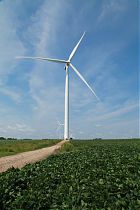
Photo credit: MidAmerican Energy
(click for larger image)
Wind Turbines for Sustainable Energy
Posted August 28, 2018, Length: 19:06
Wind has been an important, renewable source of energy for millennia. In recent decades wind power has come into its own, now producing more than 6 percent of U.S. electricity and growing rapidly. Today tens of thousands of wind turbines, many taller than 50-story buildings, dot rural landscapes, and soon will appear off our coasts. The design and construction of large-scale wind farms is a challenge involving energy planning, economics, and engineering. To learn about the development and implementation of the wind energy resource in the Midwest, and the construction and operation of wind turbines, we talk with Spencer Moore, Vice President of Generation of MidAmerican Energy Company, a subsidiary of Berkshire Hathaway Energy, located in Des Moines, Iowa.
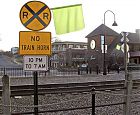
Photo courtesy of Minnetonkascenes
(click for larger image)
Mitigating Noisy Trains
Posted July 31, 2018, Length: 16:45
Noise is an almost unavoidable result of the operation of transportation and other infrastructure systems. Trains, planes, and automobiles produce noise that can be a warning but is mainly a source of annoyance and sometimes health risk to neighbors, riders, and employees.
Measurement and management of transportation noise are complex tasks requiring an understanding of physics, technology, human perception, and economics. To introduce us to some of the problems, methods, and interventions for addressing transportation noise we talk with Dr. Hugh Saurenman, president of ATS consulting, which conducts acoustic evaluations and develops mitigation strategies for transportation facilities.
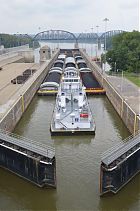
Tow boat in McAlpine Lock, Ohio River near Louisville Kentucky. Photo credit to: Gregory Thorp
(click for larger image)
Assuring a critical transportation resource: resilience of the inland waterways system
Posted June 27, 2018, Length: 18:12
The U.S. inland waterways system provides a highly efficient means for moving large quantities of bulk materials – agricultural products and natural resources – which is important both for domestic industries and the export market. But the locks and dams that support the waterway network comprise an aging infrastructure with limited capacity and almost no redundancy. Planned and unexpected lock closure for maintenance and rehabilitation impose substantial costs on our economy.
In this podcast we discuss the condition, performance, and funding of the inland waterways system with Dr. Craig Philip, who is Research Professor at Vanderbilt University and Director of VECTOR, the Vanderbilt Center for Transportation and Operational Resilience. Before joining Vanderbilt, Dr. Philip spent 30 years in the barge industry, 14 as President and CEO of Ingram Barge Lines, now the largest domestic maritime operator in the United States.

Credit: San Francisco County Transportation Authority
(click for larger image)
Transportation Network Companies and City Traffic
Posted May 29, 2018, Length: 21:47
Ride matching or Transportation Network Companies (TNCs) such as Uber and Lyft have experienced extraordinary growth in major cities around the world in the past decade. What are the impacts of these services in our cities? What is known about the scale of TNC services and the demands they are placing on city streets? To tell us more about TNCs and their impacts on one city, we talk with Joe Castiglione, Deputy Director for Technology, Data and Analysis for the San Francisco County Transportation Authority.
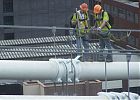
Inspecting cables on a suspension bridge. Picture credit: New York State Department of Transportation
(click for larger image)
Bridge Inspection
Posted April 24, 2018, Length: 21:12
The integrity of our infrastructure can be critical to life safety. Nowhere is this more obvious than our bridges. There are over 600,000 highway bridges in the United States, as well as a large number of transit, railroad, and pedestrian structures. Having timely and objective knowledge of the condition of these bridges is essential to assure their safety and efficiency. That knowledge comes from a program of systematic bridge inspections.
To help us understand the responsibilities and processes of bridge inspection, we’re talking with Dr. Sreenivas Alampalli, who is Director of the Structures Evaluation Services Bureau of the New York State Department of Transportation.

Los Angeles Metroliner at a station
(click for larger image)
Advances in Bus Rapid Transit
Posted March 26, 2018, Length: 21:46
Urban mobility and traffic congestion present challenges to cities around the world. Many modes and service concepts are intended to meet these mobility needs. Bus rapid transit, BRT, is a competitive option because of its service quality and capacity, as well as its potential to be less costly than fixed rail transit options. To learn about the promise and delivery of BRT in the US and around the world, we talk with Samuel Zimmerman, an experienced transportation planner, a consultant to the World Bank, and an expert on bus rapid transit.
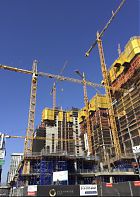
Photo of tower crane provided by Crane Safety & Inspections, Inc.
(click for larger image)
Reaching for the sky - cranes and modern infrastructure
Posted February 26, 2018, Length: 22:53
Cranes are prominent on the skyline of every city, serving as a measure of the pace of development. They are essential tools for infrastructure construction, a source of fascination for the sidewalk superintendent, and in some cases, a source of risk. To explore the role, functioning, and safety of large cranes in construction we talk with Greg Teslia, President, Crane Safety and Inspections, of Coral Springs, Florida.

Drawing of LaGuardia Airport courtesy of the Regional Plan Association, from their report "Under Water: How Sea Level Rise Threatens the Tri-State Region"
(click for larger image)
Critical Airport Fights Rising Sea Level
Posted January 29, 2018, Length: 14:09
Some airports face serious flood risks because they are flat by design and are located in coastal or riverine settings. Airports in New York are particularly vulnerable because they face both rising sea level and severe storms. Richard Barone, Vice President for Transportation of the Regional Plan Association has studied these airport flood risks and discusses them in this interview.

Repairing tornado damage in Louisiana; photo courtesy of Entergy
(click for larger image)
Turning the Power Back on: Restoring the Grid after Massive Storms
Posted December 21, 2017, Length: 20:40
Hurricanes and tornados can be devastating to infrastructure. The electric power grid is particularly vulnerable because it is both exposed and extensive. In 2017, Hurricanes Harvey along the Gulf Coast, Irma in Florida, and Maria in Puerto Rico demonstrated the risks of that vulnerability. To help us understand what it takes to restore power, and in the long run, to increase the resilience of the grid, we talk with Mike Vaughn, Vice President of Assets for the Entergy Corporation, producer and distributor of electric power the Gulf region.
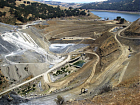
Reconstruction of the Calaveras earthfill dam in progress, showing the new spillway. Credit: Photo courtesy of San Francisco Public Utilities Commission
(click for larger image)
Securing San Francisco’s Water: Rebuilding the Calaveras Dam
Posted November 27, 2017, Length: 12:00
The infrastructure that prepares and distributes potable water to our cities requires continuing monitoring and maintenance. Many facilities are old and aging, built in an era when engineering knowledge was less and materials and methods more primitive. The San Francisco Public Utilities Commission uses a widespread collection of dams, reservoirs, aqueducts and pipe to supply 2.7 million residential and business customers, and the agency is now in the midst of a $4.6 billion renewal program that includes rebuilding the 90+ year old Calaveras dam in the East Bay. In this interview we talk with Alan Johanson, Deputy Director of the San Francisco Public Utilities Commission’s Water System Improvement Program (WSIP), to learn about the system and this program.
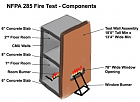
NFPA 285: Standard Fire Test Method for Evaluation of Fire Propagation Characteristics of Exterior Non-Load-Bearing Wall Assembles Containing Combustible Components (courtesy National Fire Protection Association)
(click for larger image)
High Rise Fires and the Choice of Building Materials
Posted October 30, 2017, Length: 24:07
Fire is a rare but persistent danger in tall buildings. There have been several major high rise fires around the world in recent years, notable among them the 2017 Grenfell Tower fire in London that killed at least 80 people. That event highlights the risks that may be presented by the materials used in construction and rehabilitation. To explore the connection between building materials and fire risk, we talk with Robert E. Solomon, Division Manager for Building Fire Protection of the National Fire Protection Association.

Examples of typical green infrastructure practices within a streetscape. Image credit: DC Water
(click for larger image)
Betting on Green: DC Water’s Experiment with Green Stormwater Management
Posted September 26, 2017, Length: 26:25
Managing and treating stormwater is a challenge to many cities. Building treatment plants with sufficient capacity to process large volumes of runoff that occur occasionally is not cost effective. The District of Columbia, facing a Federal consent decree to treat its stormwater, has been building subterranean storage tunnels but is now testing green treatment options that, if they work, could save much money in the long run. This experiment is funded with an unusual bonding arrangement in which lenders are betting on its success. To learn about this approach we talk with George Hawkins, Chief Executive Officer and General Manager of DC Water.
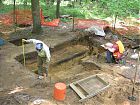
Field archaeologists mapping archaeological deposits in Ottawa County, MI in advance of M-231 construction; photo courtesy of MDOT.
(click for larger image)
Digging into the past: archeology helps move infrastructure forward
Posted September 4, 2017, Length: 22:43
Almost every infrastructure system has its foundation in the earth, and the earth can hide interesting and important secrets from the past. This creates what is perhaps a surprising role for archeology in infrastructure construction. To anticipate, identify and preserve valued subsurface finds, many infrastructure agencies engage archeologists as full-time professionals or contractors. In this interview we learn about the archeology-infrastructure connection from James Robertson, who is senior archeologist with the Michigan Department of Transportation.

Picture credit: The Alliance to Save Energy
(click for larger image)
High Risers – Elevators and Building Design
Posted July 28, 2017, Length: 19:16
Tall buildings mean vertical transportation, and elevators, the machines that do the heavy lifting for us, have made those buildings possible. Building height and elevator capabilities have evolved together, and new needs and concerns for sustainability are bringing about changes in elevators themselves. In this interview we talk with Thomas Leslie, who is Morrill Pickard Chilton Professor of Architecture at Iowa State University. He works on the integration of building sciences and arts, and his 2013 book, Chicago Skyscrapers, 1871-1934, is a valued source on the effects of technologies and materials on building design.
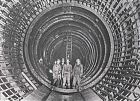
Workers inside movable concrete formworks, Delaware Aqueduct, October 31, 1940; photo from Kevin Bone's book Water-Works the Architecture and Engineering of the New York City Water Supply System.
(click for larger image)
Quenching the thirst of a megacity: New York City’s Water Supply System
Posted June 26, 2017, Length: 18:18
Clean and plentiful water is essential for life. New York City has the largest municipal water system in the United States. More than 10 million people rely on this complex of reservoirs and aqueducts, some of which are more than a century and a half old. In this podcast we learn about the structure, history, and current state of the New York City water supply system from Kevin Bone, Professor and Director of the Institute for Sustainable Design at the Irwin S. Chanin School of Architecture at The Cooper Union in New York City. His edited book, Water-Works – The Architecture and Engineering of the New York City Water Supply System, Monacelli Press, 2006, describes the development of the fresh water system for New York.
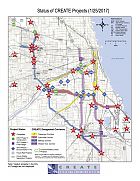
Photo Credit: CREATE Program, http://www.createprogram.org/
(click for larger image)
CREATE – Breaking the Railroad Bottleneck in Chicago
Posted May 22, 2017, Length: 20:13
Chicago is the rail hub for the nation, served by six of seven Class I railroads that form the major interchange point for east-west rail traffic. Because of the large number of rail and road conflicts, Chicago is also the focal point for congestion and delays on the national rail network. To address this problem, in 2003 the railroads joined forces with federal, state and local governments to establish a partnership called CREATE, for the Chicago Region Environmental and Transportation Efficiency Program. In this interview we talk with William Thompson, Chief Engineer of CREATE, who explains its mission, projects, and progress.

Photo credit: Central Susquehanna Valley Thruway bridge, photo courtesy of Pennsylvania DOT
(click for larger image)
Funding for Surface Transportation Infrastructure – Success in Pennsylvania
Posted April 24, 2017, Length: 15:42
Securing the money to maintain public infrastructure continues to be a top priority in the United States. The surface transportation system, roads, bridges, and public transportation facilities, need ongoing investment to assure that they meet economic and social needs. In January, 2017, the State of Pennsylvania increased its gas tax to become the highest in the nation, working under 2013 legislation that restructured the state’s approach to transportation funding. Since then Pennsylvania has made considerable progress renewing and improving its transportation infrastructure. In this interview we talk with Roger Cohen, Policy Director for the Pennsylvania Department of Transportation, to learn about his state’s strategy and progress.
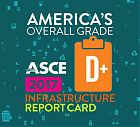
Credit: ASCE
(click for larger image)
ASCE's 2017 Infrastructure Report Card
Posted March 28, 2017, Length: 18:16
The American Society of Civil Engineers (ASCE) is a strong advocate for infrastructure in the United States. Its quadrennial Infrastructure Report Card has brought us a comprehensive assessment of that infrastructure since 1992, and the picture has not been a pretty one. Reviewing 16 major types of infrastructure, the ASCE report card tells us how we’re doing and offers directions for essential improvements. In this interview we talk with Casey Dinges, Senior Managing Director of the ASCE, about the 2017 report card. More details on ASCE’s Infrastructure Report Card is at www.infrastructurereportcard.org.

(click for larger image)
Self-Propelled Modular Transporters
Posted February 28, 2017, Length: 15:02
Big infrastructure projects often present the need to move very large objects, such as parts of chemical processing plants or even entire bridges. The capacity for moving massive components has grown to an impressive scale. In this podcast we talk with Jack Tol, Senior Sales Engineer with Mammoet, a company that provides solutions for lifting and moving large and heavy structures.

Explosive demolition of the Seattle Kingdome, March, 2000 Credit: Picture courtesy of Controlled Demolition, Inc.
(click for larger image)
Bringing Down Obsolete Infrastructure by Explosive Demolition
Posted January 25, 2017, Length: 20:10
When infrastructure becomes obsolete, unsafe, or the need for it goes away, and when the space is better used for something new, that facility must be demolished. Structures are usually disassembled piece by piece, but sometimes controlled explosion may be more efficient or necessary. This process may be no less complex than building a structure anew. In this interview we talk with Mark Loizeaux, President of Controlled Demolition, who tells us about how explosives are used to remove structures rapidly and safely.

New east span, San Francisco-Oakland Bay Bridge; photo courtesy of Caltrans
(click for larger image)
The importance of getting it right – errors in forecasting for large infrastructure projects
Posted December 20, 2016, Length: 15:12
Forecasts of the costs and benefits of infrastructure projects are important for making informed investment decisions. However, there have been many instances of major cost overruns and unexpected low utilization of new facilities. To explore the nature and pattern of such prediction errors and what we can do to make more accurate predictions, we talk with, Dr. Martin Wachs, Distinguished Professor Emeritus of Urban Planning at UCLA, formerly with the RAND Corporation and before that professor at UC Berkeley.

Photo of Sunshine Skyway Bridge, Tampa FL; photo courtesy of FIGG Engineering
(click for larger image)
Cable Stayed Bridges
Posted November 22, 2016, Length: 17:51
Cable stayed bridges have become increasingly common in the past few decade, and they seem to be the design of choice for modern bridges spanning 500 to as much as 2,000 feet. In this podcast we learn of the mechanics and the advantages of this architecturally appealing design from an expert in the field, Denny Pate, Senior Vice President and Principal Bridge Engineer with Figg Engineering in Tallahassee, Florida
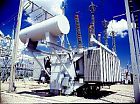
Stepdown transformer substation; photo courtesy of OSHA
(click for larger image)
Vulnerability and Resilience of the U.S. power grid
Posted October 28, 2016, Length: 18:52
A variety of natural and intentional events can disrupt components of the U.S. power grid, including large and small storms, vandalism, and cyber attacks. In this podcast, Thomas Overbye, Professor of Electrical and Computer Engineering at the University of Illinois – Urbana-Champaign describes the functioning of the grid, some of the risks it faces, its resilience, and mitigation actions for both grid operators and households.

Water sampling in Flint, MI; photo courtesy of Virginia Tech
(click for larger image)
Lead Contamination of the Water Supply – the Flint, Michigan Story
Posted September 28, 2016, Length: 20:30
Lead in the water supply is a serious threat to public health and a particular danger to children. Water supplies in many U.S. cities carry unacceptable lead concentrations because of the use of lead pipes, especially where protective water additives are not used. In this podcast we talk with Marc A. Edwards, professor in the Environmental and Water Resources Engineering group at Virginia Polytechnic Institute and State University, who has been actively engaged in both testing municipal water systems for lead, notably in Flint, Michigan and Washington, D.C., and advocating mitigation through the use of additives and the replacement of lead pipes.
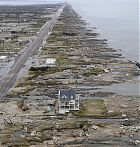
Barrier island damage due to Hurricane Ike courtesy of Texas A & M Department of Marine Sciences
(click for larger image)
Defending Against Storm Surges in the Houston-Galveston Area
Posted August 22, 2016, Length: 17:03
The threat of damaging storm surges grows as sea levels rise and the frequency of severe storms increases. Some U.S. cities on the east and Gulf coasts are particularly vulnerable to storm surges. Houston is the fourth-largest city in the country, home to the nation’s largest refining and petrochemical complex, and it may be right behind Galveston in the path of the next big Gulf hurricane. This area has been hit hard by past hurricanes, which underscores the importance of protecting it. In this podcast, Prof. Wesley Highfield of the department of Marine Sciences at Texas A&M University at Galveston discusses storm surge risks, protective options, decisions to act, and lessons for other coastal cities.

Photo of DJI Phantom Vision 2+ quadcopter provided courtesy of Denver Public Works.
(click for larger image)
Drones for flood control infrastructure inspection in Denver
Posted July 25, 2016, Length: 13:48
Unmanned aerial cameras – drones – are becoming a standard part of the infrastructure management toolkit. They are particularly useful for inspecting widely dispersed facilities in areas than can be difficult to navigate on the ground. Although there are important flight restrictions that preclude operations over populated areas, there is a growing set of applications in surveillance and inspection for large-scale infrastructure systems. In this discussion, Kevin Lewis of the Denver Department of Public Works describes the merits of using an off-the-shelf quadcopter drone to inspect critical flood control structures.

Photo of SkyConnect construction courtesy of Tampa International Airport
(click for larger image)
Tampa International Airport Master Plan
Posted June 20, 2016, Length: 16:47
Airports connect cities to the nation and the world, securing the economic viability of regions. Tampa International Airport supports important recreation and business markets, and its passenger throughput is expected to double in the next 30 years. To prepare for that growth, airport leadership has developed a three-phase master plan, construction for the first phase of which will be completed in 2017. Key changes include a new rental car facility, connected by a new people mover, and an expanded main terminal. In this podcast we learn about the master plan and the evolution of the airport infrastructure from Al Illustrato, who is Vice President for Facilities and Administration for the Tampa Airport.

The supercrane “I Lift NY” places concrete crossbeam on tower for the New NY Bridge
(click for larger image)
The New NY Bridge
Posted May 24, 2016, Length: 17:30
The New York State Thruway Authority is replacing the 6-decades-old Gov. Malcolm Wilson Tappan Zee Bridge north of New York City. To accelerate completion of the New NY Bridge, fast-tracked environmental permitting, procurement and labor agreements were combined with design-build contracting to advance a plan discussed for more than a decade to a new bridge opening in 2018. In this podcast we talk with David Capobianco, Director of Structural Design for the Thruway Authority about the features of the bridge and the process for delivering it.

Four longitudinal pontoons and two stability pontoons under construction for the SR 520 Bridge
(click for larger image)
State Route 520 Floating Bridge in Seattle
Posted April 24, 2016, Length: 12:20
There are many floating bridges in use around the world, but the Seattle region has three large bridges of this design. The State Route 520 Bridge over Lake Washington, the Gov. Albert D. Rosellini Bridge, is the longest in the world. Heavily used and assaulted by wind and waves for more than five decades, this bridge has been replaced by a new facility. Here to tell us about this large and complex project is Julie Meredith, Washington State DOT Administrator of the SR 520 replacement program.

Construction of Hudson Yard rail access tunnels to the west side of Penn Station in Manhattan.
(click for larger image)
The Gateway Program – Breaking the Rail Bottleneck in the Northeast Corridor
Posted March 23, 2016, Length: 20:35
The Gateway Program is a collaboration between Amtrak, the states of New York and New Jersey, the Port Authority of New York and New Jersey, and the U.S. Department of Transportation to address the rail bottleneck between New Jersey and New York, the busiest rail passenger corridor in the U.S. At the core of this program is construction of new twin rail tunnels under the Hudson River. These will supplement the 108 year old existing rail tunnels, which were damaged during Hurricane Sandy in 2012, and which have insufficient capacity to meet the growing demand. In this discussion we learn about the Gateway Program and plans for these new rail tunnels from Andrew Galloway, Chief of Corridor Development at Amtrak.

(click for larger image)
Water for Life: The Quest for Quantity, Quality, Efficiency, and Equity- Part III, Water for a dry land: The impact of agricultural chemicals on municipal water quality
Posted February 24, 2016, Length: 15:15
Water needs for municipalities and agriculture can intersect and sometimes conflict. In this third interview in the series exploring some of the nation’s water challenges, we talk with Bill Stowe, General Manager of the Des Moines, Iowa, Water Works, who describes the problems that drainage of chemicals, principally nitrates, from nearby farms affects the quality of input waters and the treatment technologies and costs of potable water. Driven in part by substantial advances in agricultural productivity, solutions may lie in adjustments in farming technologies and regulatory actions that address the externalities of large-scale agriculture.

(click for larger image)
Water for Life: The Quest for Quantity, Quality, Efficiency, and Equity- Part II, Water for a dry land: New Desalination Plant for San Diego
Posted January 28, 2016, Length: 14:58
Water infrastructure issues are much in the news in the U.S. — not only in the West, where drought continues to take a high toll, but also in other parts of the country, where the water needs for municipalities, energy production, commercial interests, and agriculture intersect and sometimes conflict. In this interview, one in a series of three exploring some of the nation’s water challenges, we talk with Bob Yamada, Director of Water Resources for the San Diego County Water Authority, about the mix of strategies adopted to meet the growing needs of the authority’s customers, and the new Carlsbad Desalination plant. This advanced technology reverse osmosis facility was built, financed, and will be operated through a public-private partnership under a water purchase agreement to serve the region for the next three decades.
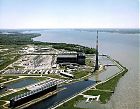
Photo courtesy of the Huntsville Times
(click for larger image)
Water for Life: The Quest for Quantity, Quality, Efficiency, and Equity - Part I , Using a Scarce Resource Wisely
Posted December 21, 2015, Length: 13:55
Water infrastructure issues are much in the news in the U.S. — not only in the West, where drought continues to take a high toll, but also in other parts of the country, where the water needs for municipalities, energy production, commercial interests, and agriculture intersect and sometimes conflict. In this interview, one in a series of three exploring some of the nation’s water challenges, we talk with Robert Glennon, Regents’ Professor and Morris K. Udall Professor of Law & Public Policy at the University of Arizona, author of Unquenchable: America’s Water Crisis and What to Do About It. Prof. Glennon discusses the trade-offs between competing demands for water, the conflicts in allocation, and strategies for both conserving and sharing scarce water more effectively.
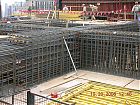
Photo credit: Paul James, Lendlease Construction
(click for larger image)
Concrete for Tall Buildings - Constructing Concrete Megastructures - Part III
Posted November 25, 2015, Length: 14:34
New and stronger concretes have become the standard material for very tall buildings, particularly residential buildings, where structural stiffness is important for the comfort of occupants. In this interview, Paul James, Senior Vice President with Lendlease U.S. Construction in Chicago, talks about the tradeoffs in design and materials selection as a function of use of the structure, the rate limiting factors in the construction of tall concrete and steel buildings, the effects of weather on construction speed, and the role of the construction engineer in material specification.

Photo Credit: Booth Hansen
(click for larger image)
Concrete for Tall Buildings - Designing Concrete Megastructures - Part II
Posted October 21, 2015, Length: 13:50
New and stronger concretes have become the standard material for very tall buildings, displacing steel in structural design. These concretes bring higher, selectable strengths and workability properties that make them particularly efficient and effective for architectural megastructures. In this interview we learn about designing tall concrete buildings in a conversation with architect and structural Joseph G. Burns, who is Managing Principal with the design firm Thornton Tomasetti in Chicago.

Photo courtesy of the Portland Cement Association
(click for larger image)
Concrete for Tall Buildings - Innovation in Infrastructure Materials - Part I
Posted September 22, 2015, Length: 17:15
Concrete is among the oldest of building materials; for example, it was the principal material in the dome of the Pantheon in Rome, completed in 128 AD. Research and innovation have led to radical changes in concrete and its applications, particularly over the past 30 years. These changes have made it possible to use concrete for the tallest buildings in the world, buildings that, only a few decades ago, would have been built of steel. In this first in a series of three podcasts we examine the science of concrete to understand the material itself, and how research has changed its properties to facilitate important new uses for concrete, particularly for megastructures. We learn about new concretes from Emeritus Professor Surendra P. Shah of Northwestern University in Evanston, Illinois.

Credit: Artist’s rendering of the new Harbor Bridge in Corpus Christi, courtesy of the Texas Department of Transportation.
(click for larger image)
What Panama Canal Expansion Means to the U.S. – Part III
Posted August 18, 2015, Length: 14:12
Breaking the Freight Bottlenecks for the Expanded Panama Canal
The effectiveness and efficiency of a marine port is closely tied to the performance and capacity of the landside transportation network that moves goods to and from ships. The expanded Panama Canal, designed to handle significantly larger ships, will challenge U.S. Atlantic and Gulf ports with those larger ships and the resulting higher rate of flow of products in and out of ports. Assuring sufficient landside capacity is a task shared by the private sector (both railroad companies and intermodal terminal operators) and governments responsible for the highway network. The Texas Department of Transportation (TxDOT) has formed a stakeholder group to identify and address the needs of shippers, carriers, and ports along the Texas Gulf Coast. TxDOT has been investing in expanded roadway infrastructure to ease key bottlenecks, particularly those affecting the major port of Houston. In this discussion, Professor Schofer explores some key activities of TxDOT with Caroline Mays, Freight Systems Branch Manager for TxDOT.

Credit: Photo courtesy of the Port of Houston Authority
(click for larger image)
What Panama Canal Expansion Means to the U.S. – Part II
Posted July 24, 2015, Length: 15:05
The Port of Houston is the principal U.S. port on the Gulf of Mexico, handling petrochemical, coal, and grain exports, and inbound consumer products. Many of the 4,000 or so ships that traverse the Houston ship channel annually transit the Panama Canal on their journeys. The expanded Canal, set to open in the winter of 2016, will support Neo-Panamax ships with as much as three times the capacity of current Panamax ships, as well as very large LNG carriers. Is the Port of Houston ready for these new ships? What public and private investments have been made and are planned to assure that Houston, and the U.S., are competitive in international trade? Roger Guenther, Executive Director of the Port of Houston Authority talks about Houston’s progress and plans with host Joseph Schofer.

Photo courtesy of the U.S. Maritime Administration
(click for larger image)
What Panama Canal Expansion Means to the U.S. - Part I
Posted June 16, 2015, Length: 12:32
The expanded Panama Canal is scheduled to open in the winter of 2016, featuring a new, parallel set of locks and deeper channels, allowing the passage of Neo-Panamax container ships carrying as many as 13,000 twenty-foot equivalent units (TEUs), in contrast to 5000 TEU capacity of today’s Panamax ships, as well as larger bulk carriers and now LNG ships. Larger ships mean lower transportation costs, and the possibility of reducing consumer prices and making some US businesses more competitive in the global markets. But a key question for the U.S. is “Are our ports, harbor, and landside transportation systems ready for these larger ships?” Are channels deep enough, cranes sufficiently large and plentiful, and do rail, road, and storage facilities have the throughput capacity to move the bulk and containerized goods? Host Joseph Schofer discusses the national perspective on port readiness with Roger Bohnert, Deputy Associate Administrator-Office of Intermodal System Development, and Yvette Fields, Director, Office of Deepwater Ports and Offshore Activities, at the U.S. Maritime Administration (MARAD). The Phase I report of MARAD’s Panama Canal impact study is here

Photo courtesy of the Annapolis Capital Gazette
(click for larger image)
Nuisance flooding – what it is and why it’s on the increase in the U.S.
Posted December 2, 2014, Length: 26:45
“Nuisance flooding” is a term for minor flooding that is not catastrophic or life-threatening, but which causes various problems for cities and towns, including overflowing storm water management systems, roads that must be closed to traffic, and deterioration of infrastructure not designed to be under water and in contact with salt-water. Much has been written in recent years about climate-related sea level rise, but a study released this July by the National Oceanic and Atmospheric Administration, or NOAA, focuses on the impacts of sea level rise as manifested in increasing frequency and magnitude of nuisance tidal flooding – and the findings are dramatic. Titled “Sea Level Rise and Nuisance Flood Frequency Changes Around the United States,” the report shows that nuisance flooding occurs much more frequently today than in the 1960s – in fact, 300 to 925 percent more frequently. Professor Schofer discusses this important topic with the lead author of that report, William Sweet, oceanographer at NOAA’s Center for Operational Oceanographic Products and Services.

Expo Line at La Cienega Station, photo by Steve Hymon/Metro.
(click for larger image)
Measure R – the innovative transportation funding process that benefits Los Angeles County
Posted November 3, 2014, Length: 28:05
Six years ago, transportation planners across the U.S. watched with great interest the progress of the November 2008 elections in Los Angeles County, California, where a proposed sales tax to fund transportation projects – called Measure R – was on the ballot. Measure R passed in that election, and its proposal was implemented: a half-cent sales tax on each taxable dollar spent in Los Angeles County, used to fund specific transportation projects for the next 30 years. This month, on the 6-year anniversary of Measure R’s passage, Los Angeles County is the scene of five major highway and transit projects under construction at the same time – an unprecedented accomplishment in U.S. metropolitan areas, where “no new taxes” is the popular mantra. Professor Schofer talks about Measure R, its process and products, with David Yale, Managing Executive Officer, County-Wide Planning and Development, for the Los Angeles Metropolitan Transportation Authority, also known as Metro.

Photo courtesy of Chicago Department of Aviation
(click for larger image)
Snow removal operations at O’Hare International Airport – and how the airport efficiently met the challenge of the extreme winter of 2013-14
Posted October 2, 2014, Length: 23:46
In the Midwestern United States, the winter of 2013-2014 was one of the most severe in recorded weather history. In Chicago, every type of transportation was affected by waves of Arctic cold and 80 inches of snowfall. At O’Hare International Airport, in suburban Chicago, the challenge of removing snow and ice from 14 miles of runways, 45 miles of taxiways, and 20 million square feet of gate areas during this period of extreme weather was immense – this for the second busiest airport in the U.S., handling more than 194,000 flight operations for the first 3 months of 2014. Yet O’Hare did such a good job that it won a top aviation industry award for excellence in snow and ice control – the coveted Balchen/Post Award issued annually by the Northeast Chapter of the American Association of Airport Executives – O’Hare was this year’s winner in the large commercial airports category. Professor Schofer discusses the snow removal challenges at O’Hare Airport and how they are met with George Lyman, Managing Deputy Commissioner, Chicago Department of Aviation, Airport Airfield Operations and Vehicle Services Sections.
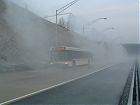
(click for larger image)
The Virginia Smart Road – a unique highway designed for transportation research
Posted September 3, 2014, Length: 19:08
Few people who travel on U.S. highways are aware that great thought went into the design and construction of the roadways, from the layout of the access ramps, to the type of pavement, to the lighting. Even fewer stop to think about the research that informs the highway planning profession. In fact, highway planning relies on its own research facilities, and they can be elaborate. But few are more elaborate than the Virginia Smart Road – a unique 2.2-mile, two-lane research highway built to Interstate Highway Standards, which is managed by the Virginia Tech Transportation Institute and maintained by the Virginia Department of Transportation. It is not open to the public, but rather serves as a laboratory for highway researchers to experiment and to learn. Professor Schofer talks about this research highway with Dr. Tom Dingus, Director of the Virginia Tech Transportation Institute.

Photo courtesy of U.S. Geological Survey
(click for larger image)
The Oso, Washington landslide – causes, impacts, information learned
Posted August 4, 2014, Length: 32:58
On March 22, 2014, during a month of heavy rains, a significant landslide occurred near the rural town of Oso, WA, about 50 miles north of Seattle, on the steep slope above a river – a slope with a history of landslide occurrences. The slide destroyed about 50 homes and killed 43 people. The event has raised questions about landslide causes and about the feasibility of landslide warning systems. Professor Schofer discusses the Oso landslide, and the topic of landslides in general, with Jeff Keaton, principal geologist for AMEC Americas in Los Angeles. He is a member of the Geotechnical Extreme Events Reconnaissance Association team, also known as GEER, which is supported by the National Science Foundation. GEER teams survey extreme event locations immediately following the occurrences, and did so at Oso.
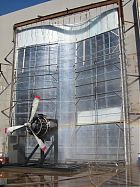
Building enclosure mock-up being tested for water penetration.
(click for larger image)
Building enclosure commissioning – important for delivering high-performance facilities and for helping to educate design and construction professionals
Posted July 2, 2014, Length: 25:15
Building enclosures – also known as building envelopes – provide buildings’ line of defense against the elements. Today, many building owners and developers are looking at the current focus on Building Enclosure Commissioning as a means not only to deliver more energy-efficient, higher-performing buildings, but also as an impetus for changes in how we educate the next generation of architects and other design and construction professionals. Professor Schofer talks about this important topic with Dan Lemieux, Principal of Wiss, Janney, Elstner Associates, the firm of engineers, architects and material scientists, who also is Chairman of the ASTM Subcommittee on the Performance of Building Enclosures.

Photo courtesy of the Boulder City Review.
(click for larger image)
The drought-necessitated tunnel project beneath Lake Mead
Posted June 2, 2014, Length: 23:23
When the Federal Bureau of Reclamation finished construction of the giant Hoover Dam near Boulder City, NV in 1936, the country anticipated that this project, which had finally tamed the Colorado River, would ensure a reliable, long-term water supply for the river basin states of Arizona, California, Colorado, Nevada, New Mexico, Utah and Wyoming. And for many decades it did so. But the Western states’ drought that has lasted the past 14 years is resulting in a near emergency situation because the water level has been falling in Lake Mead, the reservoir behind the Hoover Dam. The hosts talk with Dave Johnson, Deputy General Manager of Engineering and Operations for the Southern Nevada Water Authority about the situation and about the intake tunnel being drilled under Lake Mead to ensure Nevada continues to have access to its water source.
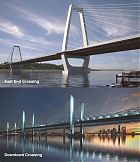
Top: East End Crossing Bridge. Bottom: Downtown Crossing Bridge
(click for larger image)
The Ohio River Bridges Project – two new bridges that will benefit the Louisville area
Posted May 2, 2014, Length: 19:13
The Ohio River Bridges Project is a $2.6 billion undertaking involving the construction of two bridges in the Louisville Metropolitan Area, a metro area that includes Kentucky and Indiana, with about 1.4 million people. One of the largest transportation projects in the country, the Ohio River Bridges Project demonstrates impressive cooperation between the two states involved. The hosts talk about the Project with Ron Heustis, Project Manager, Indiana Department of Transportation.

Photo courtesy of the Knoxville News Sentinel.
(click for larger image)
Watts Bar 2 – a look at the TVA’s impressive new nuclear power plant
Posted April 3, 2014, Length: 19:55
Unlike Germany, which is closing down all its nuclear facilities in response to the disaster in Fukushima, Japan, the U.S. will see completion of a new nuclear power plant in 2015 – the Tennessee Valley Authority’s Watts Bar 2 nuclear plant, located in east Tennessee. The hosts talk about the details of this plant, and about the outlook for nuclear power in general, with Gary Mauldin, General Manager of Project Assurance and Support Services for Watts Bar at the TVA.
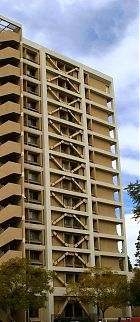
X-beam reinforcement on the Webb Tower of USC-Los Angeles
(click for larger image)
Seismic retrofits of concrete buildings – focus on California
Posted February 21, 2014, Length: 20:17
The State of California has been a world leader in earthquake safety building codes, starting with the California Seismic Code, passed in 1933 after the Long Beach earthquake. In spite of code changes and advances in design standards, retrofitting buildings to meet new codes continues to be a challenge. For example, following the 1971 San Fernando Earthquake, 1,777 California public school buildings still did not conform to the school seismic safety standards passed by the state legislature 38 years before. The main obstacle was the cost of the retrofits. Although the San Fernando Earthquake led to still more advanced design codes, The Los Angeles Times has reported that many concrete buildings in the city do not meet current seismic safety standards, putting their occupants at risk in the event of a major earthquake. Once again, the cost of retrofits was cited as the major problem. To explore the topic of seismic retrofits of concrete buildings, the hosts talk with Dr. Gregg Brandow, Professor of Engineering Practice at the University of Southern California, who is a leading expert on the seismic evaluation and retrofit of buildings.

(click for larger image)
How Carmel, Indiana became the “Roundabout Capital of the U.S.”
Posted January 24, 2014, Length: 20:21
Carmel, Indiana, a city of about 83,000 people located directly to the north of Indianapolis, has become informally known as “The Roundabout Capital of the U.S.” because of its embrace of the roundabout, a traffic concept more commonly found in Britain. Carmel has become a city nearly free of conventional four-way intersections, which means it is also nearly free of stop signs and traffic lights. At these roundabouts, traffic flows continuously, in one direction, around circular islands. The hosts discuss why the city has adopted this design – and what characteristics of the city have made the changes possible –with Carmel Mayor Jim Brainard, the man who made the roundabouts happen.

(click for larger image)
Safe transport of hazardous materials
Posted December 20, 2013, Length: 20:59
On July 6, 2013, a freight train carrying crude oil derailed and exploded in the downtown area of Lac-Mégantic, Quebec, killing at least 42 residents. Subsequently, a special emergency meeting was held in Washington, D.C. by the Federal Railroad Administration’s Railroad Safety Advisory Committee, to discuss additional rail safety measures for hazardous materials transport. The agenda of the emergency meeting included a Safety Advisory issued jointly by the FRA and the Pipeline and Hazardous Materials Safety Administration, also known as PHMSA. Directed to railroads and shippers of hazardous materials, this Advisory included a number of recommended actions to help reduce transport risks. The hosts discuss this topic of safe transport of hazardous materials with PHMSA Administrator Cynthia Quarterman.

The LEED-Gold-certified Robert H. Jackson U.S. Courthouse in Buffalo, NY
(click for larger image)
The General Service Administration’s impressive green buildings
Posted November 18, 2013, Length: 24:17
The U.S. General Services Administration’s Public Service Division, in its role as a landlord for the government, has in recent years been on the leading edge of green building design, new and retrofit construction, operations and maintenance. Among GSA’s initiatives is to “act as a green proving ground,” and many of the facilities it manages have become showcases for energy efficiency and new technology. The hosts discuss the impressive green building achievements of GSA with Dr. Dorothy Robyn, Commissioner of the Public Buildings Service.

Photo courtesy of Caltrans.
(click for larger image)
The east span replacement of the San Francisco-Oakland Bay Bridge — overview of the 11-year construction project, now complete
Posted October 15, 2013, Length: 28:36
The San Francisco-Oakland Bay Bridge consists of two separate spans, each of about 10,000 feet. The west span connects San Francisco to Yerba Buena Island in the middle of the bay, and the east span connects the island to Oakland. Daily traffic is about 280,000 vehicles. Completed in 1936, the west span is a suspension bridge, and the original east span was a cantilever design. In 1989, during the Loma Prieta earthquake, a portion of the east span collapsed, with one fatality. While the damage was repaired quickly, the decision was made to construct an earthquake-resistant new east span, of suspension design. Construction of this new span began in 2002, parallel to the original cantilever span that remained in operation during the 11 years of construction. Finally, on September 3rd, 2013, the new east span was opened for traffic. The hosts discuss the many challenges of completing this strikingly designed new Bay Bridge east span with Tony Anziano, Toll Bridge Program Manager for the California Department of Transportation, commonly called Caltrans, the department that has managed this project, in conjunction with the Bay Area Toll Authority and the California Transportation Commission.

Photo courtesy of The Boston Globe
(click for larger image)
Funding of transportation infrastructure
Posted September 26, 2013, Length: 26:05
In Europe and other developed countries of the world, infrastructure spending generally is regarded as an investment for the common good of the citizens. In the United States, on the other hand, infrastructure spending is treated in budgeting as an expense rather than an investment. Thus, in recent years Congress has tended to ignore the value of our built assets and to focus on the country’s budget deficit. How can the U.S. make infrastructure improvements given the funding obstacles that exist today? Focusing in particular on transportation infrastructure, the hosts talk with Mort Downey, a Senior Advisor for Parsons Brinckerhoff, who was Deputy Secretary of the U.S. Department of Transportation from 1993 to 2001. During his years with the DOT, he helped to double infrastructure funding.

Photo courtesy of the Chicago Sun-Times.
(click for larger image)
Bus travel in the suburbs – the challenge of providing seamless transportation for riders
Posted August 15, 2013, Length: 21:24
Transit service in low-density suburbs is usually provided with buses operating on local streets – rail transit on separate rights of way is too costly given modest ridership levels. But providing bus service in contemporary U.S. suburbs can be a challenge both to the bus operator and the travelers themselves. Secure paths for getting to and from bus stops may not exist, and protected bus stops may be rare. To encourage transit ridership, it is important to offer seamless transportation – safe, efficient, and fast connections between origin and destination, including getting to and from the bus stops. The hosts talk about the challenges of providing seamless bus infrastructure in suburban communities with Michael Bolton, Deputy Executive Director, of Pace, the Chicago metropolitan area’s suburban bus system.
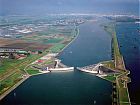
Photo of the Maeslantkering barrier, courtesy of the Rijkswaterstaat
(click for larger image)
The Netherlands flood control infrastructure – on the 60th anniversary of the North Sea Flood, a look at the impressive accomplishments
Posted July 19, 2013, Length: 20:47
This year marks the 60th anniversary of the catastrophic North Sea Flood of 1953, which occurred on January 31 and Feb. 1 of that year due to a combination of very high tides and a storm with gale-force winds. The storm surge overwhelmed many of the sea defenses in the countries bordering the North Sea. The worst flooding was in the Netherlands, where 1,836 deaths were recorded. The response to the tragedy was the creation of the Delta Works Commission, which in the following decades transformed the Netherlands flood protection system into the outstanding infrastructure it is today. The hosts talk about the Delta Works with Henk Ovink, who is currently senior advisor to Housing and Urban Development Secretary Shaun Donovan in his role of Chair of the Hurricane Sandy Rebuilding Task Force. Before joining the Task Force last April, Mr. Ovink was Director General for Spatial Planning and Water Affairs and Director of National Spatial Planning for the Ministry of Infrastructure and the Environment in the Netherlands.

Photo courtesy of the Ohio EPA.
(click for larger image)
Solid waste management – an overview of improvements in the U.S.
Posted June 25, 2013, Length: 24:22
The 2013 Edition of the American Society of Civil Engineers’ Infrastructure Report Card gave its highest grade – a B minus – to the category of solid waste management, up from a C plus in the 2009 report card. According to the ASCE, while recent figures show that Americans generate about 250 million tons of solid waste annually, about 85 million tons of that – or 34% – is recycled. As well, the generation of waste per person today is less than it was 20 years ago. The hosts discuss what the U.S. is doing right in regard to solid waste – and how we still might improve – with Debra Reinhart, a Professor in the Civil, Environmental and Construction Engineering Department at the University of Central Florida, who was in charge of the solid waste evaluations for the 2013 ASCE Infrastructure Report Card.

(click for larger image)
The Smart Grid – bringing utility electricity delivery into the 21st century
Posted May 20, 2013, Length: 26:16
The electrical grid of the United States is an enormously impressive feat of engineering that is critical to the economic and social functioning of the nation. But the fact is, it is basically a century-old power grid, not simply inefficient but vulnerable to cascading breakdowns due to both natural and manmade events. The Smart Grid is a strategy for modernizing the electrical grid. It is an automated network that directs the movement of electric power using information and communications technology to collect data on electricity supply and demand to improve efficiency, reliability, and sustainability of electric power. The hosts discuss this important topic with one of the country’s leading experts on the smart electric power grid, Massoud Amin, Professor of Electrical and Computer Engineering at the University of Minnesota.

(click for larger image)
How asset-inventory-based state of good repair analysis benefits the Santa Clara Transportation Authority
Posted April 17, 2013, Length: 21:53
Those who work in maintenance frequently find their departments are regarded by top management as a cost, rather than a contributor to the profitability of the enterprise. One reason is that the value of equipment and systems maintenance is hard to quantify. As a result, many enterprises do not budget sufficient monies for maintenance. Public transit is similar to other enterprises in this regard. However, one transit maintenance department in California has begun using an innovative budgeting process that has had impressive results. The hosts talk with Michael Hursh, Chief Operating Officer for the Santa Clara Valley Transportation Authority in San Jose about what his maintenance department has accomplished, by using asset-inventory-based state of good repair analysis, which assigns values to maintenance that are easily comprehended by management and the public.
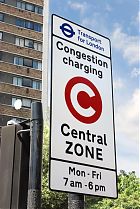
(click for larger image)
London’s congestion charge — on its 10-year anniversary, a look at lessons learned
Posted March 15, 2013, Length: 22:17
In February of 2003, the City of London, led by then-mayor Ken Livingstone, implemented a long-discussed plan for charging motor vehicles entering Central London during weekdays, with the goal of reducing traffic congestion and pollution levels. It was the largest implementation of a congestion pricing scheme anywhere it the world. While initially many residents and businesses feared that the congestion charging system would impede access, damage central area businesses, and create inequities, today, 10 years on, it is generally regarded as an effective and efficient model of urban congestion management, and cities around the world are using the London experience as a guide for their own policies. The hosts talk about lessons learned with Paul Cowperthwaite, Head of Contracted Services for Transport for London, the governmental agency responsible for transportation in the London area.
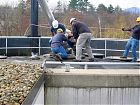
Photo courtesy of RutlandCity.com
(click for larger image)
How Vermont’s wastewater treatment plants met the challenges of Hurricane Irene
Posted February 15, 2013, Length: 17:34
Hurricane Irene originated in the Caribbean in late August 2011, and travelled up the East Coast of the U.S., causing widespread damage to infrastructure and a number of deaths. Vermont was one of the hardest hit states. Flooding from heavy rains as the storm passed on August 29 damaged roads, bridges, and several municipal wastewater treatment plants. However, the staff members did an impressive job in restoring the facilities and the water treatment quickly, for which they received an EPA excellence award. The hosts talk with Jeff Fehrs, Environmental Engineer for the Vermont Department of Environmental Conservation, about the challenges faced by the operators of Vermont’s wastewater treatment plants because of Hurricane Irene, and more generally, about the critical role that small town wastewater treatment plants play in the health and safety of their communities and the environment.

(click for larger image)
Savannah Harbor Expansion Project – extensive dredging operation will benefit Georgia and the region
Posted January 16, 2013, Length: 22:53
The Port of Savannah, GA is located on the Savannah River, about 18 miles from the Atlantic Ocean, and is operated by the Georgia Ports Authority. While the Port is the nation’s fourth busiest container port, the Savannah River shipping channel is not deep enough to accommodate the supersized cargo ships developed for the enlarged Panama Canal. The Savannah Harbor Expansion Project, or SHEP, based on 12 years of planning and research by the U.S. Army Corps of Engineers, will deepen the channel, so that it can accommodate the larger ships, and thus significantly benefit Georgia and the region. The hosts discuss this important project with Curtis Foltz, Executive Director of the Georgia Ports Authority.

Long Island, NY community after Hurricane Sandy, courtesy of U.S. Coast Guard
(click for larger image)
The impact of rising sea levels on U.S. infrastructure
Posted December 19, 2012, Length: 24:54
According to scientists, sea levels may rise 3 to 6 feet globally during the next century due to climate change. Millions of Americans live in coastal areas that would be flooded by sea level rises of these magnitudes. There also is concern regarding surges from destructive storms like Hurricane Sandy, which caused so much damage in October 2012, particularly in New York and New Jersey. Sandy was a super storm, of a type previously referred to as “once-in-a-century”, though looking ahead, some fear that such storms may become more frequent due to climate change and resulting extreme weather events. How can U.S. coastal communities deal proactively with the challenges of rising sea level and storm surges? The hosts discuss this important topic with Jessica Grannis of the Georgetown Climate Center, author of the “Sea-Level Rise Toolkit.”

Artist’s rendering of St. Croix Bridge; MnDOT
(click for larger image)
The St. Croix Crossing Project – an innovative plan that will benefit the Twin Cities area
Posted November 26, 2012, Length: 23:30
The St. Croix River, a tributary of the Mississippi River located in the states of Minnesota and Wisconsin, is crossed by the 80-year-old Stillwater Lift Bridge at Stillwater, MN, about 20 miles northeast of St. Paul. Over the years, as sprawl from the Twin Cities has increased the demand for suburban development and Stillwater has grown, the two lane lift-bridge crossing over the St. Croix has become highly congested. The decision was made to build a new bridge across the river between the two states, at a site south of Stillwater, to be called the St. Croix Bridge, beginning in 2013. It will feature a bridge design called extradosed – and will be only the second such bridge in the U.S. When the extradosed bridge is completed, the lift bridge, a historic structure, will not be torn down, but rather will be turned into a pedestrian-and-bicycle-only bridge. The hosts talk about this innovative project with Kevin Western of the Minnesota Department of Transportation, who is design engineer for the project.
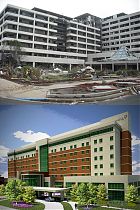
(click for larger image)
A hospital built to withstand a tornado – a look at Joplin’s new Mercy Hospital
Posted October 29, 2012, Length: 25:22
On the afternoon of May 22, 2011, an EF-5 tornado struck Joplin, MO, killing 161 people and injuring about 1,000. St. John’s Regional Medical Center in Joplin suffered substantial structural damage. Five patients and one visitor died that day. The damage to the hospital was so extensive that the facility required replacement. Because such storms are not rare in Joplin – it has been struck by three tornadoes in the past four decades – the goal was to design a new facility that would safely withstand a future tornado by learning from the structural weaknesses of the original building after such conditions. The hosts discuss the innovative storm-resistant design of the 900,000-square-foot new facility under construction, called Mercy Hospital, with John Farnen, Executive Director of Strategic Projects for Mercy.
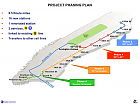
(click for larger image)
NYC’s Second Avenue subway – envisioned for three-quarters of a century, now finally becoming a reality
Posted September 28, 2012, Length: 25:00
Construction of the Second Avenue Subway on the East Side of New York City – a project that has been discussed for 75 years – began in April of 2007 and is scheduled for completion in December of 2016. This subway will consist of two miles of tunnels under Second Avenue, from 125th Street in the North to the Financial District in Lower Manhattan. The hosts talk about this long-awaited and very important addition to the New York City subway system with Peter Cafiero, Chief of Operations Planning for MTA NYC Transit.
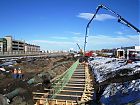
(click for larger image)
The Eagle P3 East Rail Line – a public-private partnership that will connect Denver’s downtown and airport
Posted August 24, 2012, Length: 32:21
The Eagle P3 East Rail Line is a project that will provide train service from downtown Denver’s Union Station to Denver International Airport, 22.8 miles east of the City. The Eagle project also includes the 11.8 mile Gold Line, northwest of Denver and the segment of Northwest Rail Line to Westminster as well as a rail maintenance facility. It is funded by a public-private partnership between RTD, the Federal Transit Administration and several companies that formed the Denver Transit Partners Consortium. Work began on the project in August of 2010 and is estimated to be finished in early 2016. The hosts discuss this interesting project with Richard Clarke, Assistant General Manager of Capital Programs for the Regional Transportation District.
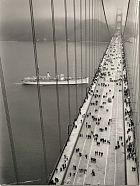
Opening ceremonies in 1937; courtesy of PDXretro.com
(click for larger image)
The Golden Gate Bridge – on its 75th anniversary, a discussion of why this iconic bridge is still is good condition
Posted July 27, 2012, Length: 29:46
This year is the 75th anniversary of the completion of the Golden Gate Bridge, the iconic suspension bridge that connects the City of San Francisco to Marin County. The 8,981-foot steel bridge – with a 4,200 foot main span – painted a distinctive dark orange, is one of the most photographed bridges in the world. While several engineers worked on the project, the Golden Gate Bridge District has given major credit for the design to Senior Engineer Charles Alton Ellis. While some younger bridges have deteriorated and been replaced, it is interesting to explore what it has taken to sustain and update this important bridge over its 75-year-life. The hosts discuss this topic with Ewa Bauer, Chief Engineer of the Golden Gate Bridge District.

(click for larger image)
A look at the Sacramento-San Joaquin River Delta levee system – and the complex challenge of ensuring its safety
Posted June 29, 2012, Length: 26:04
Two thirds of the State of California’s fresh water needs are supplied by the Sacramento-San Joaquin River Delta in Northern California. Runoff flows into the delta from the Sierra Nevada Mountains, the Cascade Range, and the Pacific Coast Range. Until the 1800s, the delta flooded each year in the spring, but in the latter part of that century, levee construction was undertaken for flood control and to reclaim land for farming – which created one of the most productive agricultural areas in the nation. Today, there are about 1,100 miles of levees in the delta. Their condition is a major concern to the State of California, because a failure could result in catastrophic flooding of the agricultural area and disruption of water supply to other parts of the state. The hosts discuss the dilemma of how to ensure the safety of the Sacramento-San Joaquin River Delta with Jeffrey Mount, Professor of Geology, at the University of California-Davis.

Chicago Central Area DeCarbonization Plan, Photo courtesy of Adrian Smith + Gordon Gill Architecture
(click for larger image)
Innovations in energy-efficient buildings
Posted May 29, 2012, Length: 24:19
According to the U.S. Green Building Council, buildings are responsible for 40% of the country’s energy consumption, and 39% of the CO2 emissions. Therefore, buildings represent an important target for greenhouse gas reduction, and during the last decade the country has seen significant progress in that regard, from the USGBC’s Leadership in Energy and Environmental Design certification system, to the Architecture 2030 Challenge, to CALGreen, the first mandatory statewide green building code in the nation. The ultimate goal is zero energy buildings – structures that make as much energy as they consume. The hosts discuss innovations in energy-efficient buildings and greenhouse gas reduction with Roger Frechette, President of PositivEnergy Practice, whose work focuses on sustainable engineering and building design.
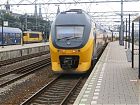
Photographer: Jason Grocholski
(click for larger image)
High speed rail – the importance of realistically evaluating costs, benefits
Posted April 27, 2012, Length: 24:06
An Infrastructure Show podcast in October of 2009 discussed high-speed-rail efforts in the Midwest. High-speed-rail plans are still in the news – with considerable activity and controversy coming from California – and funds for high speed rail in the President’s transportation budget. Plenty of uncertainty remains in the HSR arena, about future ridership, costs, and finance. It’s timely to explore these issues once again. What are the issues and what might the future hold for high speed rail in America? Professor Schofer and Tom talk about these issues as decisions are being made in Washington, California, and other places across the country.
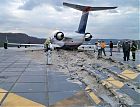
Photo courtesy of the Engineered Arresting Systems Corporation (ESCO)
(click for larger image)
EMAS – simple, effective technology improves airport runway safety
Posted March 30, 2012, Length: 23:14
The Federal Aviation Administration began conducting research in the 1990s to determine how to ensure maximum safety at airports where the full runway safety area cannot be obtained. Working in concert with the University of Dayton, the Port Authority of New York and New Jersey, and the Engineered Arresting Systems Corporation (ESCO) of Logan Township, NJ, a new technology emerged to safely arrest overrunning aircraft. The engineered material arresting system – or EMAS – uses crushable concrete placed at the end of a runway to stop an aircraft that overruns the runway. The tires of the aircraft sink into the lightweight concrete and the aircraft is decelerated as it rolls through the material. Currently, EMAS is installed at 42 U.S. airports. The hosts discuss this EMAS technology with James White, Deputy Director, Airport Safety and Standards at the FAA.

(click for larger image)
Seattle’s Alaskan Way Viaduct Replacement Project
Posted February 28, 2012, Length: 25:20
Alaskan Way is a street along Seattle’s waterfront, above which is the elevated Alaskan Way Viaduct. This double-deck roadway, completed in 1959, was damaged in the 2001 Nisqually earthquake, as was the nearby Elliott Bay Seawall. Emergency repairs were undertaken by the State of Washington, but for the long-term, the State, King County and the City of Seattle agreed that the viaduct had reached the end of its useful life and needed to be replaced. Instead of building a new viaduct, it is being replaced with a bored tunnel beneath downtown, in a massive public infrastructure project. The hosts discuss this project with Linea Laird of the Washington State Department of Transportation, who is Administrator of the Alaskan Way Viaduct Replacement Program.

(click for larger image)
Alternative fuels – an overview of U.S. progress
Posted January 31, 2012, Length: 26:46
According to the U.S. Department of Energy, transportation accounts for about two thirds of the United State’s oil consumption, and one third of the nation’s greenhouse gas emissions. As with the green buildings movement, the emerging clean vehicles movement is bringing together players from across all sectors – industry, government, and citizens – with a goal of reducing the use of polluting fuels by cars and trucks. Alternative fuels and new types of propulsion systems, including battery-electrics, are among the solutions being pursued to help reduce the country’s greenhouse gas emissions as well as our dependence on petroleum fuels. The hosts discuss alternative fuels with Patrick Davis, Director of the Vehicle Technologies Program at the U.S. Department of Energy.
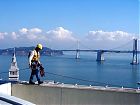
(click for larger image)
Challenging inspections — how one company performs hands-on evaluations of difficult-to-access structures
Posted December 28, 2011, Length: 25:32
The 5.8 magnitude earthquake that shook the Washington, D.C. area on Aug. 23 caused some damage to the Washington Monument, including façade cracks, that required it to be temporarily closed to the public for inspection. Sent to evaluate the damage were engineers and architects from the firm of Wiss, Janney, Elstner Associates, whose inspections required them to rappel down the sides of the 555-foot monument. While this would have been an out-of-the-ordinary job for many companies, for Wiss, Janney, Elstner, it wasn’t unique, since WJE is known throughout the world for its ability to handle challenging inspections and construction problem-solving. Since its founding in the 1950s, the Northbrook, IL-headquartered company has investigated, tested and repaired more than 75,000 projects, of all types, many of which were just as difficult to access as the exterior of the Washington Monument. The hosts discuss some of these challenging and very interesting inspections with Bruce Kaskel, a Principal of Wiss, Janney, Elstner.
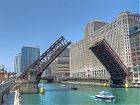
Courtesy of HistoricBridges.org
(click for larger image)
The Wells Street Bridge — a look at the upcoming rehabilitation of a historic Chicago bridge
Posted November 21, 2011, Length: 19:57
Chicago and Cook County, IL have the largest number of movable bridges in the world, a number of which are also historic. One such bridge is the Wells Street Bridge, a lift, or bascule, bridge over the Chicago River, which was built in 1922. The double-deck steel bridge, in downtown Chicago adjacent to the Merchandise Mart, carries vehicle and pedestrian traffic on the lower level and on its upper level carries the Chicago Transit Authority’s Brown and Purple Line trains to and from the Chicago Loop. The bridge opens to allow taller boat traffic to pass in certain seasons of the year. In September of 2012, the Chicago Department of Transportation plans to begin a major rehabilitation of the Wells Street Bridge. The hosts discuss this interesting project with Daniel Burke, Chief Bridge Engineer for the Chicago Department of Transportation.
Improvements needed in U.S. floodplain management
Posted October 28, 2011, Length: 27:25
In 1993, following the Great Flood in the Midwest along the Missouri and Mississippi Rivers, a White House committee was formed to assess the causes of the flood and make recommendations for improved floodplain management in the future. Lead by Gerald Galloway, a Brigadier General in the U.S. Army Corps of Engineers, the committee’s report advocated stricter land-use regulations, increased investments in flood insurance, and better coordination of flood management between federal, state, tribal and local governments. This spring, as the Missouri and Mississippi Rivers once again experienced severe flooding, the question many people were asking was “Why is this flooding happening again? Didn’t we make improvements after the Great Flood?” To answer that question, the hosts talk to the man most qualified to address it – Gerald Galloway, now a Professor in the Department of Civil and Environmental Engineering at the University of Maryland.

No. 3 reactor building, Source: TEPCO
(click for larger image)
The Fukushima I accident, and its implications for nuclear plant design
Posted September 28, 2011, Length: 23:56
The March 11, 2011 earthquake and resulting tsunami in Japan caused massive loss of life and property destruction on the northern coast and islands. In that same hard-hit vicinity, on the coast, is located the Fukushima I Nuclear Power Plant, which was flooded by the tsunami, and suffered a loss of backup power that led to a major emergency. A month later, on April 11, the Fukushima accident was classified as a Level 7 on the International Nuclear and Radiological Event Scale – the same level assigned to the Chernobyl accident in Russia in 1986. The hosts discuss the Fukushima I accident, and its implications for nuclear plant design, with Elmer Lewis, Professor Emeritus of Mechanical Engineering at Northwestern University. A frequent consultant to Argonne and Los Alamos National Laboratories, Dr. Lewis is author of the books Nuclear Power Reactor Safety and Fundamentals of Nuclear Reactor Physics.

Solar panels on roof of General Motors’ Baltimore, MD plant.
(click for larger image)
Assessing Electric Productivity in the U.S.
Posted August 29, 2011, Length: 25:09
The U.S. wastes a lot of energy, but in fact energy efficiency has been improving significantly in recent decades. However, this progress is not uniform – electric productivity in some states is markedly better than others. The details of this inconsistency, and the reasons for it, are examined in the report Assessing the Electric Productivity Gap and the U.S. Efficiency Opportunity – by the Rocky Mountain Institute, an independent, nonprofit organization in Colorado, dedicated to research in many areas relating to energy efficiency. The hosts discuss this report with one of its authors, Mathias Bell.

(click for larger image)
The quest for transportation data – knowing how people travel is key to infrastructure management, but how can this data be collected?
Posted July 25, 2011, Length: 22:31
“If you can’t measure it, you can’t manage it,” is a commonly heard engineer’s truism. Yet many engineers who work in U.S. transportation unfortunately are faced with this dilemma on a regular basis. That is, they’re tasked with planning and managing infrastructure projects without having the detailed transportation data they need to make fully informed decisions. In this podcast, Professor Schofer shares with Tom the results of transportation and travel data studies he’s been involved with as part of a Transportation Research Board committee. The goal is to find ways to collect data on how people travel – whether by car, bus, train, truck, cycle or on foot; where they travel – the routes and localities; when they travel – what days, times of day; how often they travel; and why they travel. The challenge is to collect this information in ways that will be most accurate, but without seeming to intrude on people’s privacy.
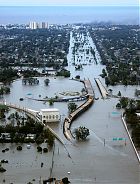
New Orleans 2005; source: U.S. Coast Guard
(click for larger image)
Avoiding disasters – how planning and wise spending can achieve effective prevention
Posted June 28, 2011, Length: 30:42
When a natural hazard, like an earthquake, strikes one country and causes great damage and loss of life, while another country, struck by a similar earthquake, is nearly unscathed, the difference often can be traced to preventive measures. Joining the hosts is Apurva Sanghi, Senior Economist at the World Bank, the team leader for the important book released last November by the World Bank and United Nations, Natural Hazards, UnNatural Disasters: the Economics of Effective Prevention. The natural hazards referred to in the title are earthquakes, droughts, floods and storms. The unnatural disasters are damages and death that follow in their wake, because of human action, or lack of action. The authors examine how governments can spend wisely to achieve effective prevention.

(click for larger image)
Philadelphia’s green infrastructure – a model for enlightened water resource management
Posted May 25, 2011, Length: 31:55
Over the past 20 years, “green infrastructure” has evolved into a sophisticated concept that cities and towns across the U.S. are beginning to use. That is, they examine ways to manage water, wastewater, energy and air quality with natural solutions like trees and plants, as well as a variety of man-made green products. Perhaps no city in the U.S. can surpass the City of Philadelphia’s embrace of green infrastructure. Their billion dollar project involves planting 300,000 trees, creating rain gardens and new wetlands, the installation of permeable pavement, green roofs, and more. In fact, their example is becoming a model for enlightened urban water resource management worldwide. The hosts discuss green strategies for storm water management with Glen Abrams, the Manager of the Philadelphia Water Department’s Office of Watersheds Planning and Strategic Policy.
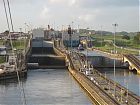
The Gatun Locks
(click for larger image)
The Panama Canal – a historic project still vital to world transportation
Posted April 28, 2011, Length: 32:59
The Panama Canal, begun in 1879 by the French and ultimately completed by the United States between 1904 and 1914, is a 48-mile-long ship canal that crosses the country of Panama, allowing ships to travel between the Atlantic and Pacific Oceans. It is a key component of the global logistics system, carrying about 15,000 ships each year – the one-millionth ship transited the Canal in October, 2010. Professor Schofer, just returned from a trip through the Canal, discusses with Tom the history of the canal and the ambitious expansion program currently underway – scheduled to deliver larger locks and deeper channels by 2014.
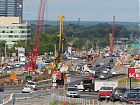
(click for larger image)
The Dulles Airport Metrorail Project – overview of an important new transit link
Posted March 30, 2011, Length: 33:57
Rail transit connections between airports and city centers have become increasingly common and heavily used around the world in recent decades. A particularly high-profile link is now being constructed in the Washington, D.C. area – a 23-mile extension of the existing Metrorail system, which will connect East Falls Church, VA to Washington Dulles International Airport. It will serve the major employment areas of Tysons Corner, Reston, and Herndon, VA, and will connect into the 106-mile Washington Metro network to provide accessibility across the region. The hosts talk about this important venture with Sam Carnaggio, Project Director for the Metropolitan Washington Airports Authority, who is leading the extension project.

Photo courtesy of Minneapolis Star Tribune
(click for larger image)
Structural failures of infrastructure projects
Posted February 25, 2011, Length: 36:15
In the month of August, 2005 and again in August, 2007, the United States experienced major infrastructure failures – in New Orleans and Minneapolis – that stunned the country with their traumatic loss of life, and drew the attention of the world. The causes of the failures were many: inadequate maintenance and inspection, vulnerable design, construction issues, as well as unexpected changes in loadings that exceeded the margin of safety. How common are structural failures of civil infrastructure? And what can we learn from them? The hosts discuss this important topic with Henry Petroski, a Professor in the Pratt School of Engineering at Duke University in Durham, NC, where he specializes in failure analysis.

(click for larger image)
Bus rapid transit systems
Posted January 27, 2011, Length: 31:22
Imagine a bus that travels in its own dedicated lane at the speed of a subway train, dramatically faster than conventional buses; a bus that brings high-speed transit to areas of the city where subways don’t run; and the costs of which are far below those of rail rapid transit. Although this sounds “too good to be true”, this is one instance where a too-good-to-be-true idea has proven realistic, workable, and highly beneficial – both abroad and in the U.S. The hosts discuss this topic with Walter Hook, Executive Director of the Institute for Transportation and Development Policy, and co-editor of the book “Bus Rapid Transit Planning Guide”.
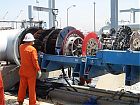
Photo of smart pig courtesy of Pacific L.A. Marine Terminal LLC
(click for larger image)
Gas and oil pipeline safety in the U.S.
Posted December 27, 2010, Length: 26:58
There are about 2.3 million miles of natural gas and hazardous liquid pipelines in the U.S. This pipeline infrastructure is overseen by the U.S. Department of Transportation, whose sub-department, the Pipeline Hazardous Material Safety Administration (PHMSA), is the main regulatory authority. The agency only has about 100 federal inspectors nationwide. The Pipeline Safety Law provides for Federal authority for regulation of interstate pipeline facilities, and a cooperative Federal/state gas and hazardous liquid pipeline safety program, where certifying state agencies could assume responsibility for intrastate pipelines. The hosts discuss this topic of pipeline safety with Cesar de Leon, former head of the Office of Pipeline Safety (now PHMSA), currently a pipeline safety engineering consultant.
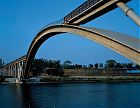
Photo of Ductal high-performance concrete project courtesy of Lafarge Ciment.
(click for larger image)
New materials for infrastructure projects
Posted November 23, 2010, Length: 26:51
Throughout history, materials used for infrastructure and transportation-related projects have followed a continuous course of development and change – from the first use of concrete in bridges by the Romans, to the first steel bridge, the Eads Bridge, built in 1874, and more recently to railroad bridges made of recycled plastic, something we discussed in a recent Infrastructure Show podcast. The hosts discuss this topic of new materials with one of the country’s top experts on the topic – architect Blaine Brownell, an Assistant Professor at the University of Minnesota’s School of Architecture, College of Design, and the author of the acclaimed book Transmaterials, which includes information on hundreds of innovative new materials for architecture. He also leads the design and research firm Transstudio.

(click for larger image)
Privately owned dams
Posted October 25, 2010, Length: 28:22
According to the U.S. Army Corps of Engineers, there are currently more than 85,000 dams in the U.S. Surprisingly, the majority of these dams are privately owned – the Association of State Dam Safety Officials estimates that fraction number at 65%. These private dams are under state regulation, but many state dam offices lack adequate operating funds, and as well, states differ widely regarding their safety standards. The publicized failures of two private dams this year – the 300-year-old Freetown, Massachusetts dam in March and the Lake Delhi dam in Iowa in July – have brought attention to the safety of privately owned dams. Just how safe are they? And who is responsible when they fail? The hosts discuss this topic with David Gutierrez of the California Department of Water Resources. He is Acting Chief in the Division of Dam Safety, and also is the current President of the Association of State Dam Safety Officials.

(click for larger image)
State of good repair for the MTA
Posted September 27, 2010, Length: 23:09
The target condition for physical infrastructure on mass transit facilities in the United States is called the state of good repair, or SGR. The concept of the state of good repair is used to help gauge current and future needs for repairing and renewing buses, rail cars, bridges, and track. Based on analyses conducted by U.S. public transit systems, mandated by the U.S. Federal Transit Administration, many facilities have not met this mark, in large measure because of insufficient funding. The challenge faced by transit operators today, particularly managers of the oldest systems in the country, is to meet, or come close to that target with available resources. The hosts discuss this important topic with Christopher Boylan, Deputy Executive Director, Corporate and Community Affairs for the New York Metropolitan Transportation Authority, who will discuss the SGR challenges involved in managing the MTA.
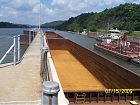
(click for larger image)
Valuing the infrastructure – a look at America’s inland waterways
Posted August 25, 2010, Length: 20:20
The inland waterway system of the United States, operated by the U.S. Army Corps of Engineers, includes 12,000 miles of commercially navigable rivers, canals and other waterways, and 240 locks. This system, which includes the Mississippi, Ohio, Columbia-Snake River systems and the Gulf Intracoastal Waterway, allows barges to transport cargo among 21 states. For bulk cargoes, barges are not only more fuel efficient than trucks and trains, but have fewer societal impacts as well. Yet, perhaps because the waterways are a rather hidden infrastructure, making the case for increased funding can be a challenge. How do we go about placing a value on this essential part of the infrastructure, and communicating this value to the public and decision-makers? The hosts discuss this topic with Bruce Lambert, Executive Director of the Institute for Trade and Transportation Studies, a multistate research institute – an economist whose prior position was as Senior Economist with the U.S. Army Corps of Engineers’ Institute of Water Resources.
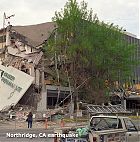
(click for larger image)
Earthquakes and structures in the U.S.
Posted August 2, 2010, Length: 22:48
Two major earthquakes happening within a month of each other in early 2010 galvanized the world’s attention. Highly publicized was the role that building codes played in the differing losses of life in the two events, in Haiti and Chile. What are the implications of a mega-quake for buildings and other structures in the U.S.? Some people looking for the next “Big One” in this country are predicting the San Andreas Fault in California, others the Cascadia Fault near the Pacific Northwest or the New Madrid Fault in the Midwest. The hosts talks about this important topic with Dr. Sharon Wood, Civil Engineering Professor and Department Chair at the University of Texas-Austin.
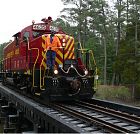
(click for larger image)
Recycled plastic bridges - innovative Virginia project showcases environmentally friendly material
Posted June 22, 2010, Length: 19:20
Corrosion of steel bridges, and of reinforcing steel in concrete bridges, is a major cause of bridge deterioration. The search for a wonder material that bears heavy loads, yet won’t corrode, has been a dream of infrastructure engineers for many years. And now perhaps such a material’s time has come. Recycled structural plastic composite – or RSPC – has been tested since the 1990s, beginning with railroad ties. More recently RSPC is being used in bridges of increasing size. This material is made of recycled plastics, such as milk containers and car bumpers, which might otherwise end up in landfills. The hosts talk with Vijay Chandra of Parsons Brinkerhoff, the principal in charge of the design of two RSPC rail bridges in Ft. Eustis, VA. They discuss the project – the largest bridges built to date of RSPC, to support the heaviest loads (120-ton locomotives used by the U.S. Army) – and also the potential for the use of this environmentally friendly material in future infrastructure projects.
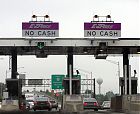
(click for larger image)
Financing America’s infrastructure
Posted May 26, 2010, Length: 13:34
To sustain America’s infrastructure in the decades ahead, the critical issue is financing. This segment differs from the usual format in that there is no guest; instead the hosts discuss financing issues and options that have been touched on in some of the past podcasts. Each year the gap between U.S. infrastructure needs and available resources has been increasing. Where will the money come from to keep the system together, maintain it, sustain the quality of service and condition, and extend its life? The hosts discuss pricing highway use, raising transit fares, increasing fuel, sales, and other taxes, and other options for paying for infrastructure. They touch on the issue of fairness to low-income citizens, and dilemmas caused by political pressure. In many developed countries, citizens are willing to pay higher taxes and fees for their infrastructure. But Americans commonly expect we should get more for less. The hosts discuss how we can achieve the long-term thinking needed to address critical infrastructure funding.

(click for larger image)
Bicycle transportation in the U.S.
Posted April 28, 2010, Length: 28:30
The pedal-driven, human-powered vehicle we know as the bicycle was invented in the 19th century. In many parts of the world today, bicycles are the main means of transport, and throughout the world they are important for use as recreational vehicles. Bicycles provide an economical, energy-efficient, low-emissions means of transporting people and cargo. For almost a century, however, the automobile has dominated non-motorized travel in developed countries. The bicycle has been regaining popularity in developed countries because of its appeal as a soft, energy-efficient mode of travel, and because of the exercise value it brings. Yet integrating bicycle traffic with automobile traffic involves a complex mix of city planning and road planning and design. European countries have been making significant advances in bicycle transportation over several decades, and now the U.S. is starting to catch up, with progress of its own. The hosts discuss this interesting topic with Gabe Rousseau, Manager of the Federal Highway Administration’s Bicycle and Pedestrian Program.

(click for larger image)
America's power infrastructure
Posted March 24, 2010, Length: 25:26
The topic of this podcast is America’s power infrastructure — the power plants and transmission lines that make up the electric grid. Seventy years ago, in 1940, only 10% of energy in this country was used to produce electricity. Growing population and rapidly changing technologies have pushed this percentage to 40%, and the percentage is rising. While the country has been steadily adding electrical generation capacity, a key problem is that the transmission network in many areas of the country is outdated and can’t handle the peak demand for electricity. The hosts talk with Mark McGranaghan, Director-Distribution Research, for the Electric Power Research Institute (EPRI).
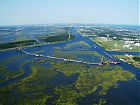
(click for larger image)
Storm risk reduction projects in New Orleans – a look at the IHNC surge barrier
Posted February 24, 2010, Length: 26:06
In 2006, following the damage done by Hurricanes Katrina and Rita, Congress authorized the U.S. Army Corps of Engineers to begin a number of projects designed to reduce the risk to the New Orleans metropolitan area from a 100-year storm. One of the largest projects in the plan is the Inner Harbor Navigation Canal Lake Borgne Surge Reduction Project – or IHNC Surge Barrier for short. It is the largest surge barrier of its kind in the world, stretching about 2 miles across the Gulf Intracoastal Waterway and the Mississippi River Outlet. Its purpose is to reduce the risk of storm surge from the Gulf of Mexico and Lake Borgne, protecting some of the most vulnerable areas in the region, including New Orleans East, New Orleans Metro, the 9th Ward and St. Bernard Parish. It is the largest design/build civil works project that the Corps has ever built, estimated to cost about $1.3 billion. The hosts talk with Rick Kendrick, Chief of Program Execution for the U.S. Army Corps of Engineers’ Hurricane Protection Office in New Orleans, which is overseeing approximately $5.9 billion of risk reduction construction projects in Southeast Louisiana, including the IHNC Surge Barrier.

(click for larger image)
Going green – Dallas-Ft. Worth International Airport’s sustainable success story
Posted January 26, 2010, Length: 22:16
Hear the impressive story of how Dallas-Ft. Worth International Airport has become one of the country’s model green airports. DFW, the third busiest airport in the world in terms of aircraft movements and the seventh busiest in terms of passenger traffic, covers more than 29.2 square miles and supports more than 300,000 jobs. In 2008, DFW launched an airport-wide Sustainability Policy and Program, as part of the airport’s strategic plan. The key elements of the Sustainability Initiative to date include: environmental management, energy efficiency and renewable energy, waste minimization and recycling, wildlife management, safety management, emergency response, asset development, and a clean vehicle fleet program. The hosts talk with Jim Crites, DFW Executive Vice President of Operations, about these notable green achievements.
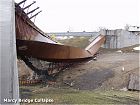
(click for larger image)
The role of forensic engineering in failure investigation and prevention
Posted December 24, 2009, Length: 21:43
Whenever a high-visibility infrastructure failure occurs, the main question everyone wants to know is: why? Was it a design error? A failure of materials? A result of human error? It is the job of the forensic engineer to investigate all the myriad of factors that might have led to a failure. Such investigations often are lengthy, and costly. But they are essential, to prevent recurrence of similar failures. The hosts talk with Dr. David Corr, Clinical Associate Professor in the Department of Civil and Environmental Engineering at Northwestern University, about this topic, with a focus on two significant infrastructure disasters: the collapse of the Mianus River Bridge on Interstate 95 in Connecticut in 1983, and the 2006 failure of ceiling panels in the Fort Point Tunnel – a part of the Big Dig in Boston. Also included are details on the Marcy Bridge Collapse, which occurred in 2002 in Upstate New York.

(click for larger image)
The 91 Express Lanes: a model for congestion pricing
Posted November 25, 2009, Length: 18:57
The 91 Express Lanes is a 10-mile road located in Orange County, California. Opened in 1995, it was the first privately financed toll road built in the U.S. since the 1940s. It was also unique in that it was the first fully automated toll project in the world, and also marked this country’s first application of congestion pricing, in which tolls increase at times of busiest road use, and decrease during less travelled hours, with high-occupancy vehicles paying discounted tolls. As with any project that was a first of its kind, the 91 Express Lanes have proved to be a learning experience, and they have been studied by transportation professionals around the world. The hosts discuss this topic with Chris Norby, Member of the Orange County Transportation Authority’s Board of Directors, and Orange County Supervisor, 4th District.

(click for larger image)
High-speed rail: current proposals for the Midwest
Posted October 27, 2009, Length: 19:59
High-speed rail refers to passenger train service operating at an average speed of 124 mph or higher. Most European countries have extensive high-speed rail networks, as do Japan and China. The United States currently has no high-speed rail service. Although technically Amtrak’s Acela Express is a high-speed train, which does in fact briefly reach 150 miles per hour on some routes, its average speed is significantly less – for example, 80 miles per hour between New York City and Washington, D.C. High-speed trains have had real success abroad, but are market conditions in the U.S. suitable for this technology? The hosts talk with Rick Harnish, Executive Director of the Midwest High Speed Rail Association, about this topic, mainly focusing on the Midwest states.
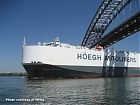
(click for larger image)
The Bayonne Bridge – a challenge for container shipping
Posted September 22, 2009, Length: 12:48
The Bayonne Bridge, completed in 1931, connects Bayonne, NJ and Staten Island, NY. The world’s fourth longest steel arch bridge, it stands 151 feet above the Kill van Kull tidal strait. It is this 151 foot height above mean water level that presents the problem for container ships travelling to reach the container terminals at Staten Island and Port Newark. Some container ships today are too high to pass under the bridge, but this problem will become worse when the Panama Canal expansion is completed, and the next generation of larger container ships, called “Post-Panamax” vessels, will be afloat. The hosts talk with Frank McDonough, President of the New York Shipping Association, about the challenge the Bayonne Bridge presents to New York and New Jersey shipping, and the options that have been discussed to address the bridge’s height problem.
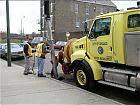
(click for larger image)
Municipal water leakage, and how the City of Chicago addresses the challenge of stopping leaks
Posted August 25, 2009, Length: 27:09
Inadvertent water loss – leakage – within water distribution networks is an infrastructure problem that exists throughout the country and around the world. The hosts talk with Bill Bresnahan, 1st Deputy Commissioner of the Chicago Department of Water Management about the causes of leakage and how the City of Chicago addresses the challenge of stopping leaks. Chicago draws water from Lake Michigan via two intake cribs and processes it through the two largest water treatment plants of their kind in the world. The Department of Water Management’s 12 pumping stations send the water through more than 4,200 miles of distribution mains. These stations have a combined pumping capacity of some 2.1 billion gallons daily, and they distribute water to 2.9 million customers in the City and 2.5 million others in the nearby suburbs.

(click for larger image)
The Heartland Corridor Project
Posted July 30, 2009, Length: 29:19
The hosts talk with James Carter Jr., Chief Engineer for Bridges and Structures with the Norfolk Southern Corporation, about the impressive Heartland Corridor Project. The Heartland Corridor Project is a collaboration between the Norfolk Southern Railroad and state and federal governments, intended to improve rail service between the Port of Norfolk and places in the Midwest. Among other elements of the project, it will provide a more direct routing for double-stacked container trains between Norfolk, Virginia and western Virginia, West Virginia, and Ohio, as far as Columbus. The project was begun in 2007, with completion anticipated in 2010. Included in the podcast is information on tunnel modification, intermodal terminals, double-stacked trains and freight, and funding.
The Wenchuan Earthquake, and a discussion of earthquakes triggered by dams and reservoirs
Posted June 26, 2009, Length: 25:58
Two earthquake and dam experts from Northwestern University in Evanston, IL — Dr. Seth Stein, William Deering Professor of Earth and Planetary Sciences and Dr. Charles Dowding, Professor of Civil and Environmental Engineering — talk with the hosts about the magnitude 7.99 Wenchuan Earthquake that occurred in China on May 12, 2008, and the possibility that this earthquake was triggered by the operations of the nearby Zipingpu dam and its reservoir. They expand the discussion to include other examples of suspected dam/reservoir-triggered earthquakes, offering their thoughts on the benefits and risks of dam locations, and the ability of structures to withstand ground movement.
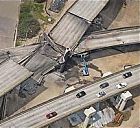
(click for larger image)
The aftermath of the Oakland, CA I-580 ramp collapse — focus on advanced technologies
Posted May 26, 2009, Length: 25:33
Tom Taylor, Branch Chief of Surveys Coordination/New Technologies for Caltrans District 4, talks with the hosts about the advanced survey technologies used in rebuilding the I-580 ramp in Oakland, CA, totally destroyed in a tanker fire on April 29, 2007. This ramp is a critical element of the Bay Area freeway network. It was rebuilt in only 26 days in an extremely fast-track project that used innovative contracting methods and relied on extensive use of advanced measurement technologies. These included aerial photography and photogrammetry, laser scanning, and the use of advanced survey instruments for field measurement of the damage and exact position and dimensions of the remaining structure — thus defining the gap that needed to be filled by the replacement ramp.

(click for larger image)
New I-35W bridge in Minneapolis
Posted April 21, 2009, Length: 22:59
Interviewed is Linda Figg, whose company, Figg Bridge Engineers of Tallahassee, FL, designed the new Minneapolis I-35W Bridge to replace the I-35W Mississippi River Bridge that collapsed on Aug. 1, 2007. The new bridge opened on September 18, 2008. Linda discusses this fast-track project, features of the new bridge, and lessons learned from the bridge failure and replacement.

(click for larger image)
Introduction; ASCE Report Card
Posted March 25, 2009, Length: 28:40
The hosts introduce this series of podcasts with a definition of the infrastructure and a discussion of why it is important to us. They talk about trends in infrastructure characteristics and condition and consider why the infrastructure has been so much in the news recently. Then they move on to an assessment of the nation’s infrastructure, talking with Casey Dinges of the American Society of Civil Engineers about his organization’s Infrastructure Report Card. This broad assessment of our infrastructure is prepared by the ASCE every 5 years. It grades the condition of our bridges, dams, roads, rail systems, inland waterways, and 10 more systems. Casey describes the most recent Report Card, released in January of 2009.
The Infrastructure Show is sponsored by Northwestern University.
Descriptions of photos at top of page, from left to right:
 Bayonne Bridge, from Bayonne, NJ to Staten Island, NY;
Bayonne Bridge, from Bayonne, NJ to Staten Island, NY;
 the Tom Moreland Interchange in Atlanta, GA;
the Tom Moreland Interchange in Atlanta, GA;
 Dworshak Dam, in Clearwater County, ID;
Dworshak Dam, in Clearwater County, ID;
 a transmission substation in Orem, UT.
a transmission substation in Orem, UT.
All photos courtesy of Wikipedia.